This article is available to Premium members of Popular Archaeology.
Become a member or upgrade to a Premium membership: REGISTER HERE.
Member Login:
This is the example article
This article is available to Premium members of Popular Archaeology.
Become a member or upgrade to a Premium membership: REGISTER HERE.
Member Login:
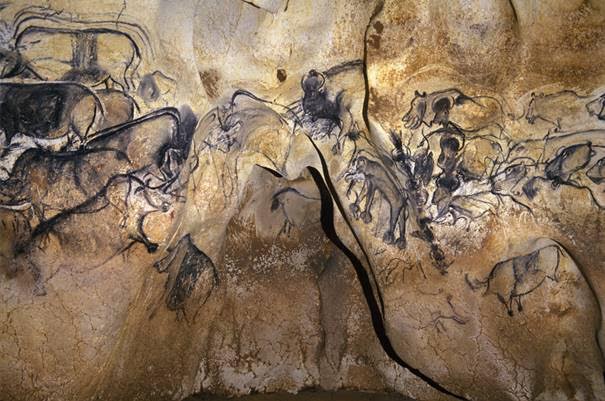
CNRS—The oldest signs of man-made fire date back about 400,000 years. Hundreds of thousands of years later, at around 40,000 BCE, Homo sapiens, having mastered the flickering flame, began dwelling in caves seasonally. These humans left behind them rock art, proof of their former occupancy. Chauvet Cave (Grotte Chauvet–Pont d’Arc), a UNESCO World Heritage site, bears faithful testimony of the very beginnings of cave art. A study* bringing together several CNRS researchers1 has examined wood charcoal left by humans of the Aurignacian (37,000–33,500 BCE) and Gravettian (31,000–28,000 BCE) cultures who frequented the Chauvet–Pont d’Arc site. Of the 171 samples studied by the scientists, all but one are derived from pine trees. The presence of these conifers indicates a cold, dry climate and steppe interspersed with pine, birch, and juniper groves. Pine would have been burnt for the large flames it produces, illuminating the cave walls while the prehistoric artists executed their works. Some of the fire pits found at the cave were used solely to produce pine charcoal for use in the paintings.
_____________________________

© C. Fritz / Chauvet Team / MC
These findings are published in Antiquity (April 25, 2018).
Article Source: A CNRS news release.
1.Researchers at the following organizations::
– Laboratory Cultures et environnements. Préhistoire, Antiquité, Moyen Âge (CEPAM) (CNRS/Université Nice Sophia Antipolis)
– Laboratory Environnements, dynamiques et territoires de la montagne (EDYTEM) (CNRS/Université Savoie Mont-Blanc)
– Laboratory De la préhistoire à l’actuel : culture, environnement et anthropologie (PACEA) (CNRS/Université de Bordeaux/Ministère de la Culture)
– Laboratory Travaux de recherches archéologiques sur les cultures, les espaces et les sociétés (TRACES) (CNRS/Université Toulouse-Jean Jaurès/Ministère de la Culture)
– Institut de recherche sur les archéomateriaux (IRAMAT) (CNRS/CEA/Université de technologie Belfort-Montbéliard/Université d’Orléans/Université Bordeaux Montaigne)
– The DRAC de la région Auvergne-Rhône-Alpes
– The MSHS de Toulouse (CNRS/Universités Toulouse-Jean-Jaurès, Toulouse III-Paul-Sabatier et Toulouse 1 Capitole/Sciences Po Toulouse/COMUE Université fédérale Toulouse Midi-Pyrénées)
*Illuminating the cave, drawing in black : wood charcoal analysis at Chauvet-Pont d’Arc. Isabelle Théry-Parisot, Stéphanie Thiébault, Jean-Jacques Delannoy, Catherine Ferrier, Valérie Feruglio, Carole Fritz, Bernard Gely, Pierre Guibert, Julien Monney, Gilles Tosello, Jean Clottes et Jean-Michel Geneste. Antiquity, 2018 April 25.
_____________________________
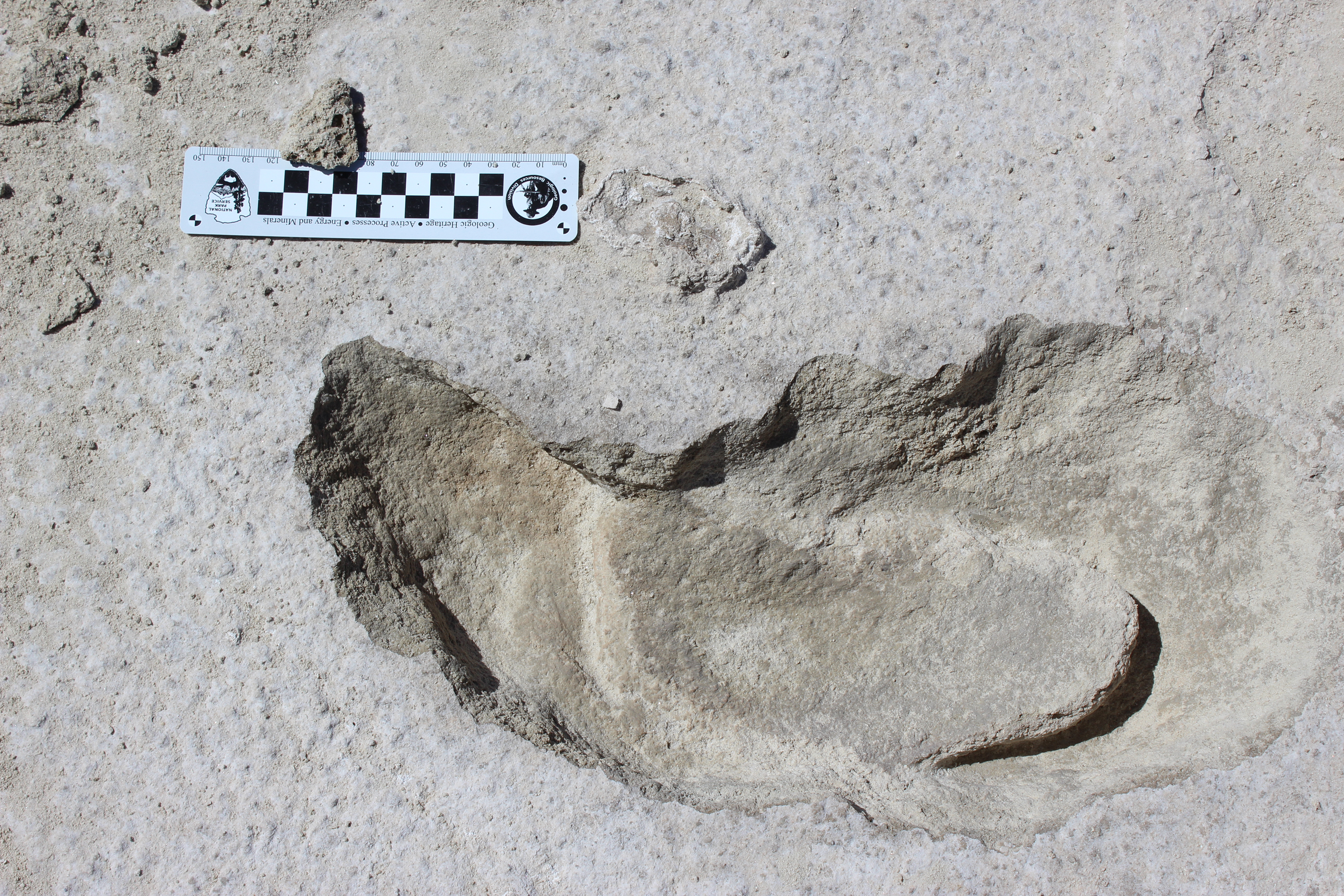
Science Advances—At White Sands National Monument in New Mexico, an international team has uncovered fossilized footprints of humans for the first time, and notably, the human prints were inside those of fossilized footprints from giant ground sloths – tall creatures with sharp claws. The results suggest that human hunters stalked these large, now-extinct animals thousands of years ago, helping to paint a picture of how ancient humans and animals interacted, in this instance. Researchers have been studying fossilized footprints for decades, a way to understand how different species related with one other, but predator-prey interactions revealed by vertebrate fossils (particularly those that could shed light on human hunting practices) are extremely rare. Now, however, at White Sands National Monument, researchers led by David Bustos and using the latest geophysical techniques have unearthed the tracks of not only animals, but also of humans – with the latter being “inside” the former, providing evidence that humans followed closely behind, or even “stalked” the sloths. What’s more, say the authors, the sloth tracks show evidence of evasion and defensive behavior when associated with human tracks, leading Bustos and his team to infer that humans may have been hunting these animals in the late Pleistocene, a period when many large mammals went extinct. Understanding the way in which our ancestors tackled big prey is important because big animals like this would have been associated with greater risk to their human predators. The results may also help shed light on any role humans may have had in the extinction of giant ground sloths, the authors say.
____________________________
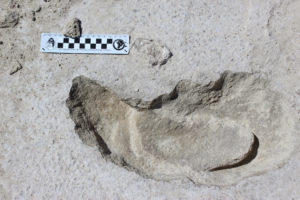
Human footprint inside a sloth track. This composite track is part of a trackway in which the human appears to have stalked the sloth. Matthew Bennett, Bournemouth University
____________________________
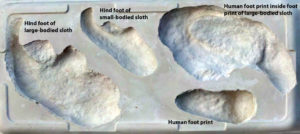
Composite cast showing a range of footprints from the White Sands National Monument (WHSA) field site.
David Bustos, National Park Service
____________________________
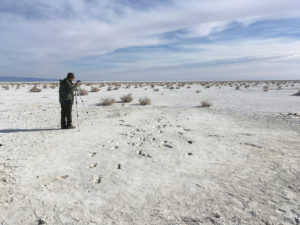
General view of Alkali Flat at White Sands National Monument (New Mexico) showing a series of excavated footprints in the foreground. Matthew Bennett, Bournemouth University
____________________________

Reconstruction based on the fossil footprint evidence showing how human hunters stalked giant ground sloth to distract them before trying to land a killing blow. Alex McClelland, Bournemouth University
____________________________
Article Source: Science Advances news release. Science Advances is published by AAAS, the nonprofit science society.
____________________________

PURDUE UNIVERSITY—WEST LAFAYETTE, Ind.—An ancient horse burial at Tombos along the Nile River Valley shows that a member of the horse family thousands of years ago was more important to the culture than previously thought, which provides a window into human-animal relationships more than 3,000 years ago.
The research findings are published in Antiquity*. The Tombos horse was discovered in 2011, and members of the Purdue team – professor Michele Buzon and alumna Sarah Schrader – played a part in the excavation and analysis. The horse is dated to the Third Intermediate Period, 1050-728 B.C.E., and it was found more than 5 feet underground in a tomb. The horse, with some chestnut-colored fur remaining, had been buried in a funeral position with a burial shroud.
“It was clear that the horse was an intentional burial, which was super fascinating,” said Buzon, a professor of anthropology. “Remnants of fabric on the hooves indicate the presence of a burial shroud. Changes on the bones and iron pieces of a bridle suggest that the horse may have pulled a chariot. We hadn’t found anything like this in our previous excavations at Tombos. Animal remains are very rare at the site.”
Buzon, a bioarchaeologist, has worked with Stuart Tyson Smith, anthropology professor at the University of California, Santa Barbara, for 18 years at this site in modern-day Sudan, and both are principal investigators on the project. Buzon uses health and cultural evidence from more than 3,000-year-old burial sites to understand the lives of Nubians and Egyptians during the New Kingdom Empire. This is when Egyptians colonized the area in about 1500 B.C. to gain access to trade routes on the Nile River. Over the years, hundreds of artifacts, including pottery, tools, carvings and dishes were unearthed at this burial site for about 200 individuals.
“Finding the horse was unexpected,” Schrader said. “Initially, we weren’t sure if it was modern or not. But as we slowly uncovered the remains, we began to find artifacts associated with the horse, such as the scarab, the shroud and the iron cheekpiece. At that point, we realized how significant this find was. Of course, we became even more excited when the carbon-14 dates were assessed and confirmed how old the horse was.”
Schrader, who graduated from Purdue in 2013 with a doctoral degree in anthropology, is an assistant professor of human osteoarchaeology at Leiden University in The Netherlands. Schrader is lead author on this article, and she helped frame this find within the context of Nubian history.
Once the archaeologists discovered the horse, Sandra Olsen, curator-in-charge at the Biodiversity Institute and Natural History Museum at the University of Kansas and a well-known ancient horse expert, was invited to Purdue to analyze the horse skeleton. Buzon coordinated the analysis between the team, and she established the chronology of the horse via radiocarbon dating.
“The horse was treated well in life, seeing as how it lived to a mature age,” Schrader said. “It also was important to the people of ancient Tombos because it was buried – a rite that is usually reserved for humans. Furthermore, the fact that one of the earliest pieces of iron from Africa was found in association with the horse reiterates how special it was to the people. It is also important to assess the context of Tombos with regard to the horse – the horse is an important and rare find. The fact that it is buried at Tombos indicates that this town may have served an important function in the post-colonial Napatan Period.”
_______________________________
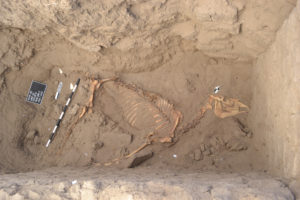
The Tombos horse was discovered in 2011. The ancient horse is dated to the Third Intermediate Period, 1050-728 B.C.E., and it was found more than 5 feet underground in a tomb. The horse, with some chestnut-colored fur remaining, had been buried in a funeral position with a burial shroud. The discovery provides a window into human-animal relationships more than 3,000 years ago. Photo provided
______________________________
The excavation was supported by grants from the National Science Foundation; the National Geographic Society; University of California, Santa Barbara; Purdue and the Schiff-Giorgini Foundation. The excavation and research also were supported by El Hassan Ahmed, director of fieldwork at the National Corporation of Antiquities and Museums.
Article Source: Purdue University news release
*Symbolic equids and Kushite state formation: a horse burial at Tombos
Sarah A. Schrader1, Stuart Tyson Smith2, Sandra Olsen3 and Michele Buzon4
https:/
______________________________
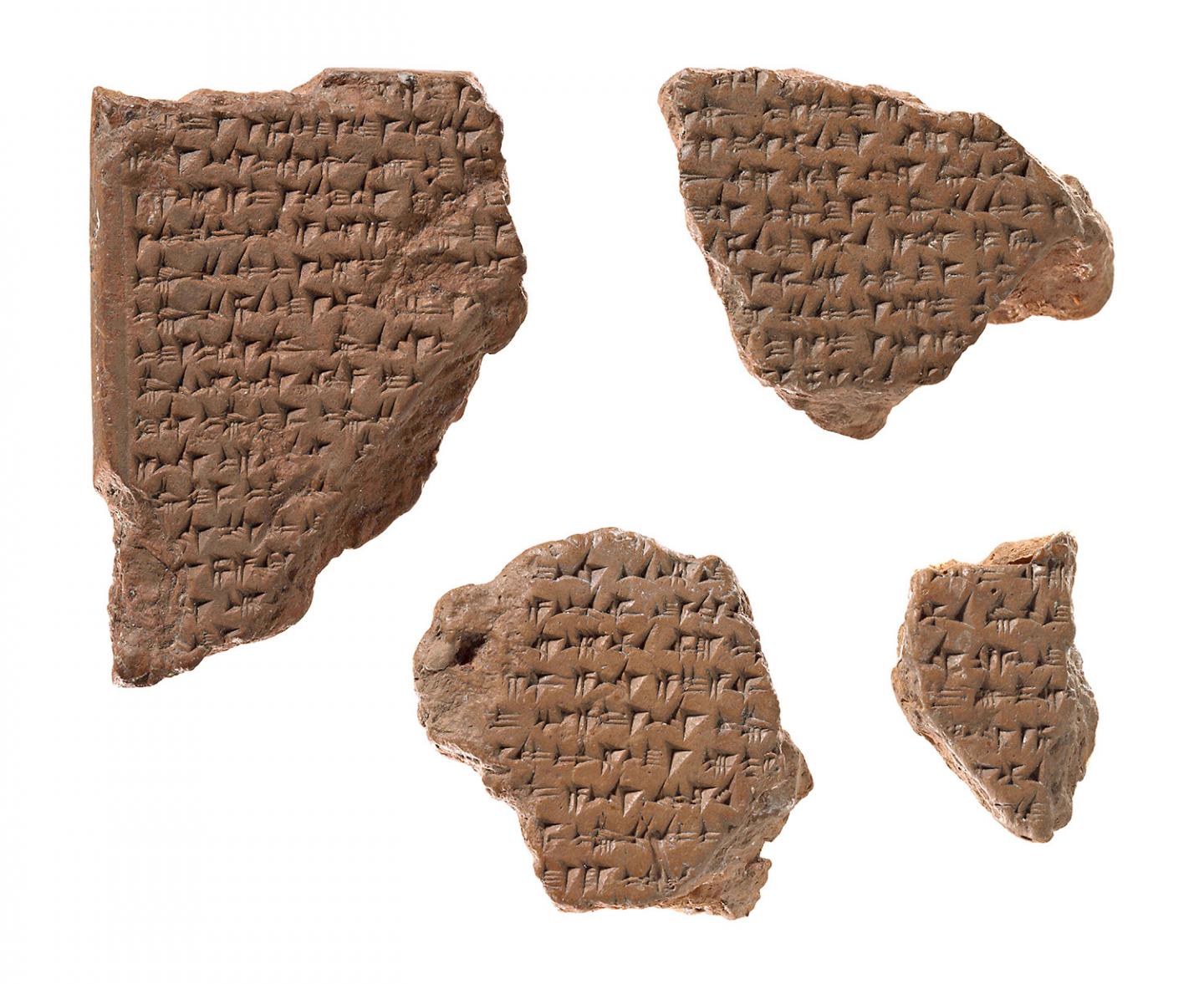
CLUSTER OF EXCELLENCE “RELIGION AND POLITICS”—According to archaeologists, the world’s oldest peace treaty disproves the widespread notion that in antiquity, peace was not brought about by negotiations, but always by humiliating those who had lost. “More than 3,200 years ago, Egyptians and Hittites ensured each other mutual support in the treaty; neither of them triumphed. This must have been preceded by much negotiating, as is evidenced by extensive correspondence between the rulers”, say Director Prof. Dr Achim Lichtenberger and Curator Dr Helge Nieswandt of the University of Münster’s Archaeological Museum. “Although the ‘victorious peace’ dominates over the ‘peace of reconciliation’ in peace images of antiquity, our research shows that the latter also existed.” From 28 April, the museum will present a copy of the oldest contract (fig. 1) from the Berlin Pergamon Museum in the exhibition project “Frieden. Von der Antike bis heute” (Peace. From Antiquity to the Present Day). Another copy can be seen in the United Nations Building in New York.
The researchers of the museum and of the Cluster of Excellence “Religion and Politics” also do away with other clichés. A large number of peace images were created not in times of peace, but in times of war, such as the Roman goddess of peace Pax showing on countless coins. “Despite the glorification of war in antiquity, which undoubtedly existed and alienates us: images of the ideal of peace were particularly widespread during wars,” says Nieswandt. He will present the “inflation of peace” on coins (fig. 2) on 23 May at the Cluster of Excellence’s conference “PEACE. Theories, Images and Strategies from Antiquity to the Present Day”, which is part of the exhibition project.
In the exhibition with the subtitle “Eirene – Pax. Frieden in der Antike” (Peace in Antiquity), the museum will also, for the first time, present a bronze-coloured copy of the famous goddess of peace “Eirene” by sculptor Cephisodotus (fig. 3). It symbolises that with peace comes prosperity. “Despite the glorification of war, people from antiquity always knew that it is not war but peace that leads to wealth,” says Lichtenberger. This ideal is also illustrated by many of the other 160 antique exhibits such as the messenger staff, the handshake and ears of grain (fig. 4). “They show how strongly our Western peace symbols of today are rooted in ancient Greek and Roman images and how they have repeated themselves over centuries. Accordingly, the ancient illustrations are often familiar to us.”Bronze-coloured goddess of peace and doves in animal idyll
According to Lichtenberger, even the most famous symbol of peace today, the dove, originates from antiquity. The derivation is not linear, however: “While in antiquity, the dove itself did not signify peace, it was closely associated with Aphrodite, the goddess of love. It also appeared in animal idylls in which the peaceful coexistence of animals represented peace. The dove could thus be adapted as a symbol of peace by Christians.” An allegory of peace in the tradition of antiquity from 1659 by Flemish painter Theodoor van Thulden, depicting horn of plenty and caduceus, also shows how far the ancient symbols extend into later centuries. “According to ancient ideas, the caduceus granted its bearer diplomatic immunity,” says Nieswandt. “The fact that the goddess Pax holds it on numerous ancient coin depictions underlines once more the importance that negotiated peace had for antiquity as well”. (fig. 5)
Regarding the numerous coin depictions of the goddess of peace “Pax” (fig. 2), Helge Nieswandt explains that she was often, particularly in times of war, shown on coins, the first mass medium of mankind, because rulers thus offered an ideal in reply to reality. The researcher will show this in his conference lecture on 23 May using an example of Roman antiquity: “When the order of the Roman Empire fell apart in the 3rd century AD, and when mostly short-lived soldier emperors took turns, there was an ‘inflation of peace’ on coins.” Researchers see this as one example of many for the fact that people in all centuries expressed and depicted a longing for peace, but were not able to secure it in the long run. This guiding principle characterises the exhibition “Peace. From Antiquity to the Present Day”.
About the bronze copy of Cephisodotus’ Eirene, the scholar explains that it is a statue whose Greek original from the 4th century BC has not survived, but whose popularity and appearance are attested to by numerous Roman copies. Goddess of peace Eirene holds the infant Plutus, the personification of wealth, in her arms. The Archaeological Museum has commissioned a restorer with the bronze-coloured copy of this 2.05-metre and thus larger-than-life representation and will for the first time present it to the public at the opening of the exhibition on 28 April. “According to our investigations, the bronze, which is shining like gold, is only one possibility of several coloured versions, but in any case it is more plausible than the white of the plaster. The Münster reconstruction is to be understood as an incentive to see the statue differently than before. (sca/vvm)
______________________________
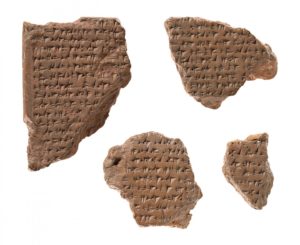
This is the oldest-preserved peace treaty between Ramesses II and attušili III, c. 1259 B.C. Staatliche Museen zu Berlin, Vorderasiatisches Museum, Olaf M. Teßmer
Article Source: CLUSTER OF EXCELLENCE “RELIGION AND POLITICS“ news release
_______________________________
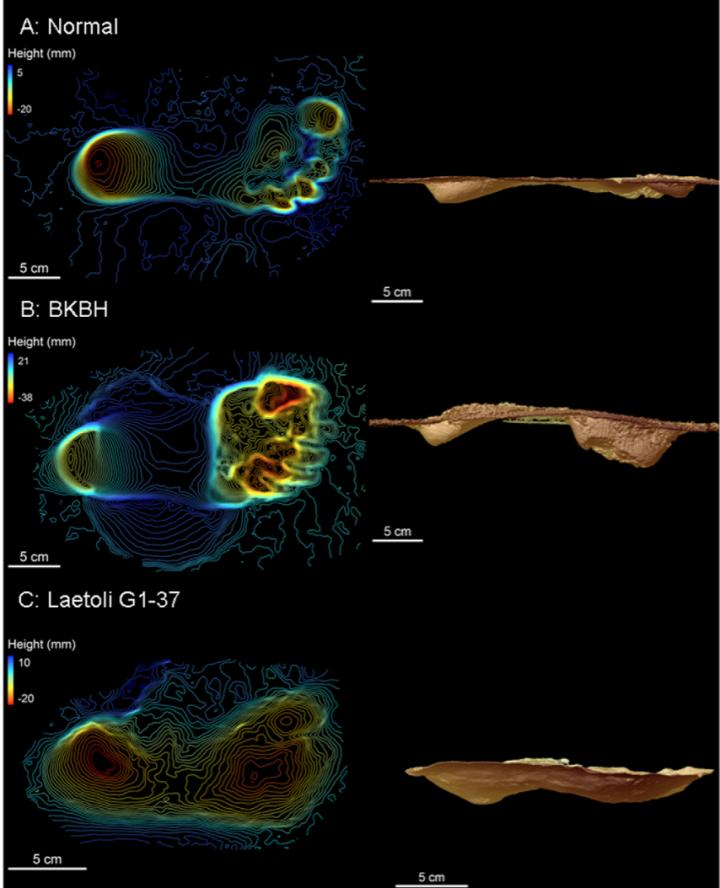
EXPERIMENTAL BIOLOGY 2018—Ever since scientists realized that humans evolved from a succession of primate ancestors, the public imagination has been focused on the inflection point when those ancestors switched from ape-like shuffling to walking upright as we do today. Scientists have long been focused on the question, too, because the answer is important to understanding how our ancestors lived, hunted and evolved.
A close examination of 3.6-million-year-old hominin footprints discovered in Laetoli, Tanzania suggests our ancestors evolved the hallmark trait of extended leg, human-like bipedalism substantially earlier than previously thought.
“Fossil footprints are truly the only direct evidence of walking in the past,” said David Raichlen, PhD, associate professor at the University of Arizona. “By 3.6 million years ago, our data suggest that if you can account for differences in size, hominins were walking in a way that is very similar to living humans. While there may have been some nuanced differences, in general, these hominins probably looked like us when they walked.”
Raichlen will present the research at the American Association of Anatomists annual meeting during the 2018 Experimental Biology meeting, held April 21-25 in San Diego.
The species that comprises modern humans, Homo sapiens sapiens, emerged roughly 200,000-300,000 years ago. The genus Homo is thought to have emerged about 2-2.5 million years ago. The term hominin is used to refer to a broader set of ancestors that existed before that, although there is debate about the nature of the species included in that grouping and the relationships among them.
It is thought that hominins began walking on two legs around 7 million years ago, but based on the way other primates evolved, it is considered likely that these early ancestors retained a crouched, bent-legged walking posture for some time.
Raichlen and his team use a variety of methods to reconstruct walking mechanics based on fossilized footprints and skeletons of early human ancestors. Their most recent results use a combination of experimental data and morphological studies to show that the footprints at Laetoli are consistent with fully upright, human-like bipedal walking.
In one experiment, the team compared the depth and shape of the Laetoli footprints to those left by eight volunteers–modern humans–walking in either an upright or stooped posture (in which the knees and hips are bent). When they analyzed the impression made by the toe versus the heel, which reflects how the center of pressure moves along your foot as you take a step, they found the footprints at Laeoli were much more similar to the footprints made by modern humans walking upright.
Walking upright with the legs fully extended uses less energy than bipedal walking in a more ape-like crouched manner, allowing one to endure longer journeys. This suggests that the switch to a more human-like gait likely had something to do with how our ancestors found food–and how far they had to travel to find it.
“The data suggest that by this time in our evolutionary history, selection for reduced energy expenditures during walking was strong,” said Raichlen. “This work suggests that, by 3.6 million years ago, climate and habitat changes likely led to the need for ancestral hominins to walk longer distances during their daily foraging bouts. Selection may have acted at this time to improve energy economy during locomotion, generating the human-like mechanics we employ today.”
Although the evidence is strong that hominins were walking upright by 3.6 million years ago, the exact stage when the locomotion of our ancestors diverged from that of modern-day apes remains unknown, Raichlen said. Answering that will likely require following in more–even older–footprints.
_________________________________
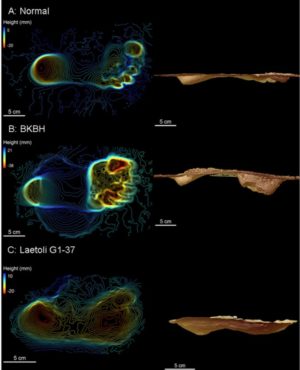
Footprints from (A) a modern human walking normally, (B) a modern human walking with a stooped posture known as the “bent knees, bent hip,” or BKBH, posture, and (C) 3.6 million-year-old hominin footprints found in Laetoli, Tanzania. The team’s analysis suggests ancient hominins probably walked in a way that is very similar to modern humans. David Raichlen, University of Arizona.
Article Source: Experimental Biology 2018 news release
_________________________________
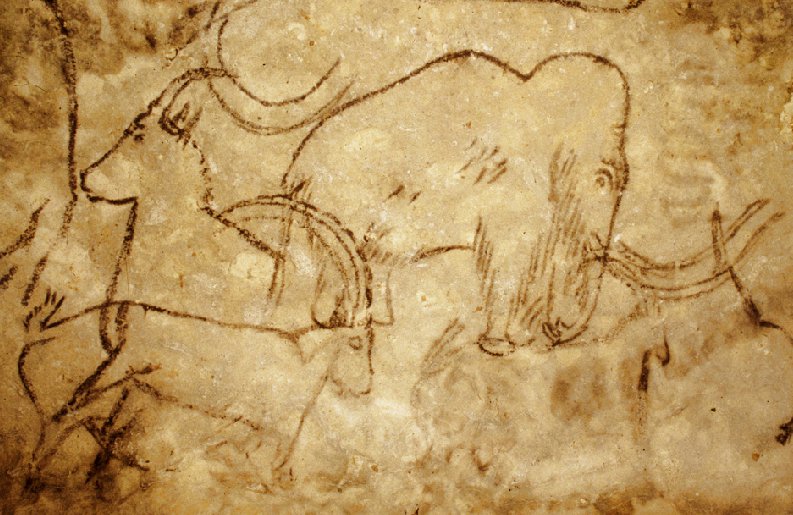
AMERICAN ASSOCIATION FOR THE ADVANCEMENT OF SCIENCE—The dispersal of humans out of Africa coincided with a dramatic global reduction in the size of mammals, a new study* reveals. This “downsizing” trend may continue, suggest the authors, to the extent that, in just a couple hundred years, the largest terrestrial mammal left may be the domestic cow, weighing in at 900 kilograms (kg). Felisa A. Smith et al. sought to understand how the size of mammals has changed over time. They updated and created two datasets that capture the global distribution and body size of terrestrial mammals that lived between 66 million years ago through the present. The authors found a substantial bias in mammal extinction during the periods when humans were dispersing around the globe, whereby species that went extinct tended to be two to three times bigger than mammals that survived, a trend that was evident globally. Notably, prior to humans’ migration out of Africa 125,000 years ago, Africa was home to mammals of smaller size (with a mean body mass roughly half that of mammals found in Eurasia), which the authors suggest is reflective of the hominin-mammal interactions that had already been at play. Perhaps most striking is the reduction of mammals in the New World during the late Pleistocene, which coincided with humans’ adoption of long-range weapons. The authors report a greater than 10-fold drop in both mean and maximum body mass of mammals during this time; for example, mean mass of terrestrial mammals in North America fell from 98.0 to 7.6 kg. If current trends continue, the mean body mass of mammals in North America will drop from 7.7 to 4.9 kg in a few hundred years, the authors say. As mammals play a critical role in shaping ecosystems, the downsizing trend will have a cascading impact on other organisms.
Article Source: AAAS news release
*”Body size downgrading of mammals over the late Quaternary,” by F.A. Smith at University of New Mexico in Albuquerque, NM; R.E. Elliott Smith at University of California, San Diego in San Diego, CA; S.K. Lyons at University of Nebraska-Lincoln in Lincoln, NE; J.L. Payne at Stanford University in Stanford, CA.
_______________________________

NEW YORK INSTITUTE OF TECHNOLOGY–Scientists have long wondered why the physical traits of Neanderthals, the ancestors of modern humans, differ greatly from today’s man. In particular, researchers have deliberated the factors that necessitated early man’s forward-projecting face and oversized nose. As published in the April 4 edition of Proceedings of the Royal Society B, an international research team led by a professor at the University of New England in Australia, with the aid of an anatomy and fluid dynamics expert at NYIT College of Osteopathic Medicine at Arkansas State University (NYITCOM at A-State), may have the answer.
Recognized as the original “cavemen,” Neanderthals, who lived 60,000 years ago, were the first fossil humans ever discovered when remains were uncovered in the early 19th century in what is now Belgium. Remnants indicated these ancestors were shorter and far more robust and muscular than today’s average human. Perhaps most noticeably, Neanderthals had a much larger nose and longer face, with the mid-part of the face jutting dramatically forward.
“The physical variations between modern man and ‘cavemen’ have caused Neanderthals to be historically characterized as barbarous, dimwitted and generally inferior to the contemporary human in almost every way,” said Jason Bourke, Ph.D., assistant professor of Anatomy at NYITCOM at A-State and the fluid dynamics expert on the international research team. “Yet, as we learn more about their diet, spiritual beliefs, and behavior, we realize that Neanderthals were likely more sophisticated than previously assumed, and aside from their facial structure, may not have been so radically different from today’s humans. Now the question begs, why they looked so different.”
Aiming to answer that question, the researchers applied sophisticated computer-based methods and simulations to compare the physiological behavior of Neanderthal to today’s human. Three-dimensional virtual models of multiple individuals were created from Computed Tomography (CT) scans and simulations were performed to replicate facial responses to various everyday situations, including biting at the front teeth and inhaling cold air through the nose. In addition, the researchers simulated a more primitive early human, Homo heidelbergensis, to predict how Neanderthal’s predecessor behaved and determine the direction of evolution.
“Homo heidelbergensis provided us with an evolutionary compass,” Bourke explained. “It allowed us figure out what features Neanderthals inherited vs. the novel anatomy their species evolved.”
This approach permitted the researchers to ignore the Neanderthals’ strong brow ridge (an inherited feature) and focus more on their enlarged nose, which was deemed a unique feature of the species. Existing theories suggest that their large facial structure was required for a stronger bite to eat harder food, but the engineering tests suggested a different reason for these distinctive features. Unlike today’s humans, who breathe through a combination of the nose and mouth based on activity level, it appears that Neanderthals relied more on its nose for breathing – a function that would have required a more prominent mid-face.
“While our data found Neanderthals to be somewhat less efficient in conditioning air than today’s humans, they greatly outrivaled today’s humans in their ability to transport large volumes of air through the nasal passage into and out of the lungs,” said Bourke.
In fact, the reconstructions demonstrated that the Neanderthals’ noses were able to transport twice as much air to the lungs than today’s humans, which could have powered the more strenuous and energetic lifestyle required to chase and hunt large animals. The ability to condition large amounts of oxygen in colder temperatures would have also allowed Neanderthals to remain warm and active in Ice Age environments.
Providing many firsts for the anatomy field, the study is the first to include mechanical engineering simulations of Neanderthal biting, as well as the first to provide a comparative analysis of airflow and heat transfer in the nasal passages of multiple extinct human relatives.
_____________________________
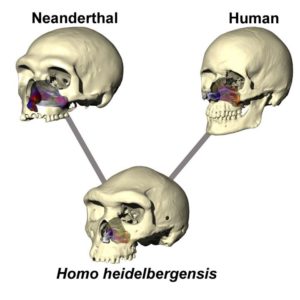
Image illustrates the difference in skull and nose shape in the three human species tested. Airflow is color-coded for temperature (warmer colors = warmer air, cooler colors = colder air). Lines indicate that Neanderthal and modern-humans likely diverged from an ancestor very close to Homo heidelbergensis. University of New England, Armidale, New South Wales
_____________________________
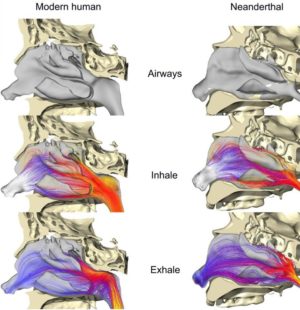
Airflow comparison between a modern human (left) and Neanderthal (right) when breathing in air at 0°C (32°F), with warmer colors representing warmer air flow and cooler colors representing colder air flow. Skulls have been cut down the midline to better visualize the airway. As demonstrated, Neanderthals were better suited to condition large amounts of cold air than today’s humans. University of New England, Armidale, New South Wales
_____________________________
Article Source: New York Institute of Technology news release
_____________________________
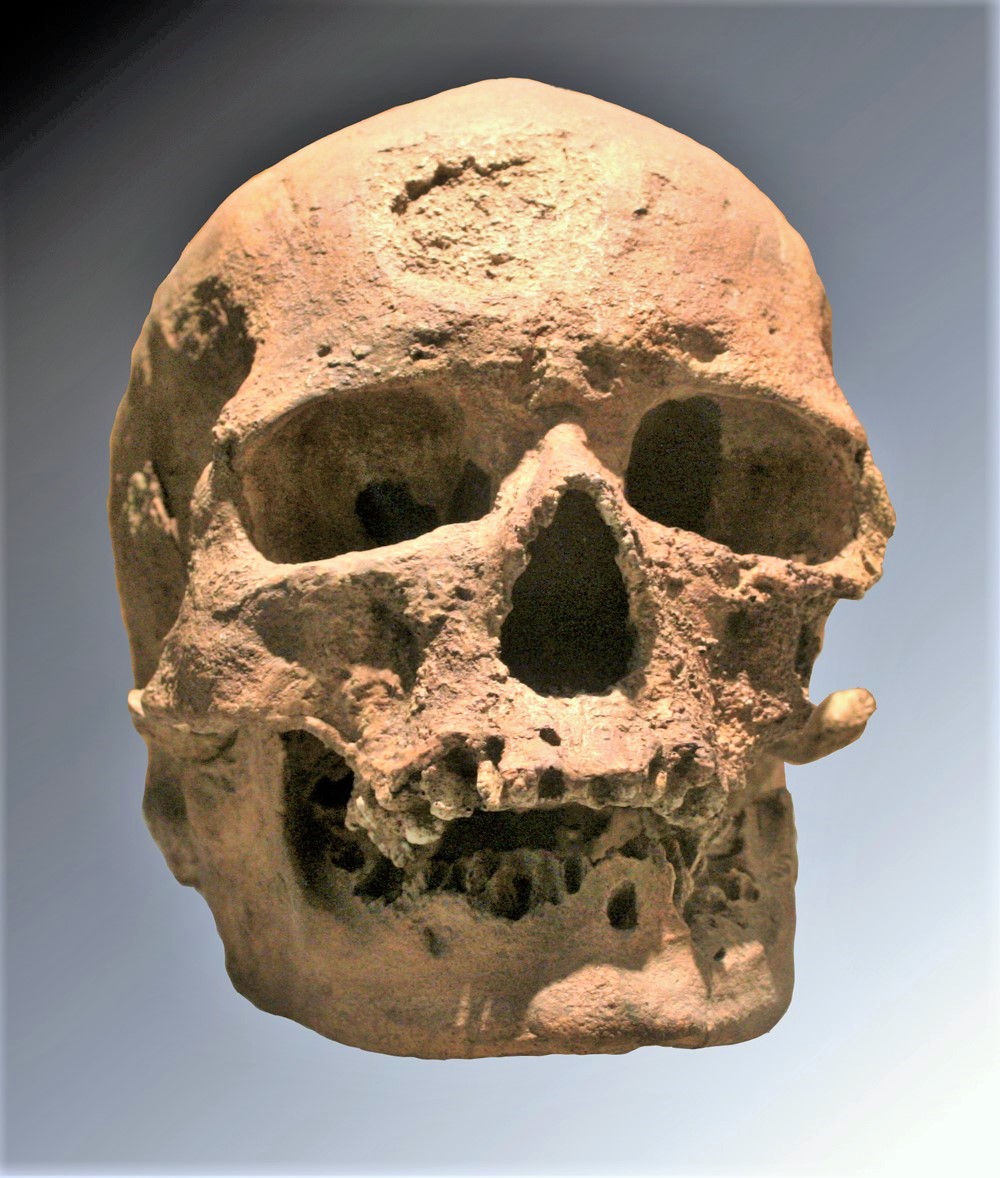
UNIVERSITY OF MONTREAL—Trade and social networking helped our Homo sapiens ancestors survive a climate-changing volcanic eruption 40,000 years ago, giving hope that we will be able to ride out global warming by staying interconnected, a new study suggests.
Analyzing ancient tools, ornaments and human remains from a prehistoric rock shelter called Riparo Bombrini, in Liguria on the Italian Riviera, archeologists at Université de Montréal and the University of Genoa conclude that the key to survival is cooperation.
Their study was published in early April in the Journal of Quaternary Science.
“Liguria is where some of the first Homo sapiens, more or less our direct ancestors, lived in Europe,” said Julien Riel-Salvatore, a professor of archeology at UdeM who co-authored the study with his Italian colleague Fabio Negrino. “They came after the Neanderthals, and unlike them, when they were faced with sudden changes in their climate they didn’t go locally extinct or abandon the region – they adapted.”
Home sapiens had been living in the region for about 1,000 years when a “super-eruption” in the Phlegraean Fields in southern Italy, west of present-day Naples, devastated much of Europe. “It used to be thought that this wiped out most of the early Homo sapiens in Europe, but we’ve been able to show that some were able to deal with the situation just fine. They survived by dealing with the uncertainty of sudden change.”
In their work, the archeologists gathered tool fragments such as bladelets – small flakes knocked off large stones to use as barbs and slicing components of weapons for hunting – that showed the ingenuity of our early ancestors. Some of the flint they used was brought in from hundreds of kilometres away, indicating a very extensive social and trading network that helped them survive for the next 4,000 years.
“They had a link to people living far away, so that if things went haywire in the territory where they lived, they had the social option of depending on people they’d built relationships with – the broader the network, the easier it was to survive,” said Riel-Salvatore, whose evidence also includes rare skeletal remains and a child’s tooth, as well as shell and stone ornaments, that show Homo sapiens were there.
His study mirrors others on an even older archeological site, Mount Toba on the Indonesian island of Sumatra, where a super-eruption 75,000 years ago was once thought to have come close to wiping out humanity entirely, a theory since disproven. In both cases, archeology has shown that evolution isn’t always as dramatic as we think.
“This seems to be part of a pattern where humans are more adaptable and more resilient in the face of these enormously disruptive events,” said Riel-Salvatore. “These events can be really terrible, but only in a limited way, not across continents or globally.”
It’s a bit of a leap to say that what happened tens of thousands of years ago can help predict how humans today will cope with climate change, but learning from the past does help situate us for the future – and even rebut climate-change deniers, he added.
“It underscores the importance of archeology in being able to inform the more immediate issues we face. Cooperation and resilient social networks were really key in helping people ride out dramatic climate change in the past. And considering some of the challenges we’re facing nowadays, and some of the entrenched positions we have to deal with, maybe this notion that cooperation is fundamental is something we can communicate as a take-home lesson.”
The bulk of the data the researchers gathered for their study was excavated between 2002 and 2005 from Riparo Bombrini, a part of the Balzi Rossi site complex from the Middle-Upper Paleolithic period that was first probed in 1938 and excavated in 1976. Over the next three years, Riel-Salvatore and Negrino intend to delve further into why the Neanderthal population there disappeared and was replaced by the better-equipped – and better-connected – Homo sapiens.
__________________________
Article Source: University of Montreal news release
“Human adaptations to climatic change in Liguria across the Middle-Upper Paleolithic transition,” by Julien Riel?Salvatore and Fabio Negrino, was published April 3, 2018 in the Journal of Quaternary Science.
Featured Image, above: Skull of ancient Homo sapiens. Wikimedia Commons
__________________________
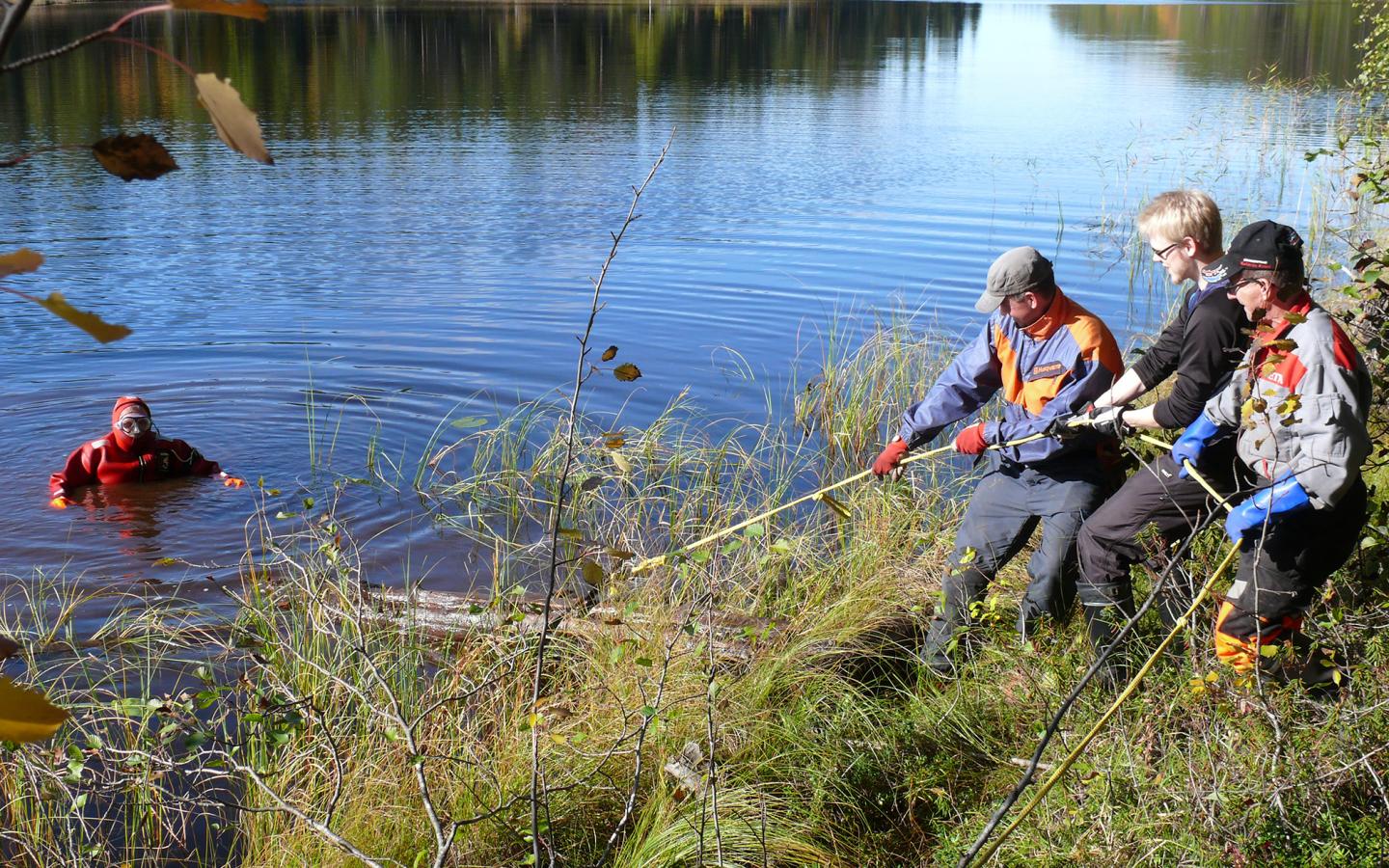
Editor’s Note: The following University of Helsinki news release publicizes the latest research supporting one of the causes of the fall of the Eastern Roman Empire, also written about by author and professor Kyle Harper in his latest book, The Fate of Rome, and published in a major feature premium article by Kyle Harper, The Archaeology of the Invisible and the Fall of Rome, in the Spring 2018 issue of Popular Archaeology Magazine.
UNIVERSITY OF HELSINKI—A recent study published in an esteemed academic journal indicates that volcanic eruptions in the mid 500s resulted in an unusually gloomy and cold period. A joint research project of the Chronology Laboratory of the Finnish Museum of Natural History and Natural Resources Institute Finland (Luke) suggests that the years 536 and 541-544 CE were very difficult for many people.
An extended period of little light may make it difficult for humans to survive. The level of production of plants is dependent on the amount of available sunlight. Food production, i.e, farming and animal husbandry, rely on the same solar energy. Humans, meanwhile, become more prone to disease if they are not exposed to enough sunlight to produce vitamin D.
“Our research shows that the climate anomaly, which covered all of the northern hemisphere, was the compound result of several volcanic eruptions,” says Markku Oinonen, director of the Chronology Laboratory.
The aerosols that were released into the atmosphere with the eruptions covered the sun for a long time.
The exceptionally poor climate conditions were significantly detrimental to farming and reduced the production of vitamin D among the populace. This means that the people who were already weakened by hunger also had to grapple with a compromised immune system.
Trees are a record of the past
The study is based on dendrochronology or tree-ring dating. The series of annual growth rings from subfossil – or intact – tree deposits covers the past 7,600 years. The trees are often found on the bottom of small lakes, and Luke has been taking samples and recording the findings since the 1990s.
“Researchers have put together an annual growth ring calendar of treeline pine spanning more than 7,600 years. Various historical events can be contrasted with the calendar. The growth ring calendar is an important indicator of global climate change,” says researcher Samuli Helama from Luke.
The samples in the recent study were dated with the help of the growth ring calendar at Luke, and sample shavings were carved out of them for each calendar year. The Chronology Laboratory then conducted isotope analyses on the samples.
Carbon isotopes indicate summer weather
The results of the study are based on the analysis of the variation of carbon isotopes in the annual growth rings of trees. The variety in carbon isotopes reflects the photosynthesis of the trees, which in turn is largely dependent on the amount of solar radiation available during the summer.
The new study tracks the correlation of carbon isotope variation and volcanic eruptions from the 19th century until recent years, and shows the dramatic reduction in available sunlight in 536 as well as between 541 and 544 CE. The variation of summer temperatures was similarly reconstructed on the basis of the density of the trees’ annual growth rings.
___________________________
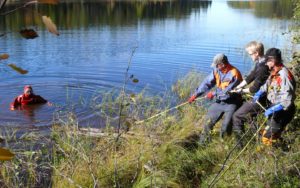
A subfossil tree trunk being lifted out of a lake. Samuli Helama / Natural Resources Institute Finland
Hard times brought the plague
The unusually poor years coincide with the bubonic plague epidemic that devastated the Roman Empire. The epidemic caused by the Yersinia pestis bacterium began in 542 CE and killed approximately half, or more, of the inhabitants of what was then considered the Eastern Roman Empire. The plague spread through Europe, from the Mediterranean, possibly as far north as Finland, and had killed tens of millions of people by the 8th century.
The study was conducted as a consortium project by the University of Helsinki and Luke, with participation from researchers of the University of Eastern Finland, the Finnish Meteorological Institute, the Geological Survey of Finland and the University of Turku. The research was funded by the Academy of Finland.
Article Source: University of Helsinki news release
The study was published in the international series Scientific Reports: Helama S, Arppe L, Uusitalo J, Holopainen J, Mäkelä H M, Mäkinen H, Mielikäinen K, Nöjd P, Sutinen R, Taavitsainen J-P, Timonen M and Oinonen M 2018. Volcanic dust veils from sixth century tree-ring isotopes linked to reduced irradiance, primary production and human health. Scientific Reports 8, http://www.
For readers interested in further reading about this topic, see The Archaeology of the Invisible and the Fall of Rome by Kyle Harper.
________________________________

PLOS—Renewed excavations at the Late Pleistocene Leang Burung 2 rock shelter archaeological site on the island of Sulawesi, Indonesia have revealed new evidence of early human occupation, according to findings by Adam Brumm of Griffith University’s Australian Research Centre for Human Evolution, and colleagues from Indonesia’s National Research Centre for Archaeology (ARKENAS), published* April 11, 2018 in the journal PLOS ONE.
The island of Sulawesi is generally assumed to have been a key stepping-stone on early human dispersal routes with modern humans possibly making first landfall as early as 65,000 years ago, based on early colonization dates for Australia. The limestone rock-shelter at Leang Burung 2 in the Maros karsts of Sulawesi has long held significance in our understanding of early human dispersals into ‘Wallacea’, the vast zone of oceanic islands between continental Asia and Australia. In 1975, artifacts recovered at Leang Burung 2 were interpreted as evidence of occupation by modern humans between 25,000 and 34,000 years ago, but excavations were discontinued before bedrock or sterile deposits were reached.
Brumm and colleagues returned to Leang Burung 2 in 2007 and between 2011 and 2013 to reassess the dating and interpretation of early findings and to dig nearly 3 meters deeper for more ancient materials. Their analysis suggests that the upper layers of sediment are of mixed age, and thus the artifacts from the 1975 excavation may be younger than previously thought. But in the newly-excavated lower levels of the deposit, they discovered and dated archaic cobble-based cores and flakes that indicate human occupation at the site at least 50,000 years ago. These new artifacts provide key insights into the history of human occupation and cultural evolution across the Indonesian region.
While the identity of the ancient toolmakers is unknown, it is possible that these were the same early modern humans that produced 40,000-year-old cave art found in neighbouring caves or they could be a separate population of more ancient humans or human relatives that had long inhabited Sulawesi. The researchers note that these recent excavations do not yet reach the lowest layers of the deposit, and that further exploration at nearby sites may recover even older remains of human occupation, as well as more dateable materials to confirm their preliminary age estimates.
Adam Brumm says: “We have uncovered archaeological evidence for an ancient population of ‘Ice Age’ hunter-gatherers that inhabited Leang Burung 2 rock-shelter around 50,000 years ago. This early ‘culture’, so far as it can be discerned from stone tools and associated faunal remains, is strikingly different to that of the modern human foragers who were creating sophisticated cave art in nearby sites by 40,000 years ago, perhaps suggesting the first inhabitants of this site may not only have been members of a different culture but also a distinct human species.”
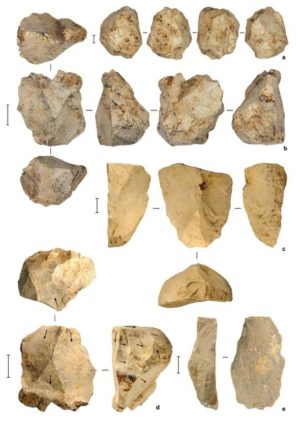
These are stone artifacts excavated from the deep deposits at Leang Burung 2. (a) limestone core, square D10, spit 54 (Layer A); (b) limestone core, square D11, spit 55 (Layer A/B); (c) retouched limestone flake, square D11, spit 47 (Layer I); (d) multiplatform limestone core, square D11, spit 55. (Layer A); (e) limestone flake, square D11, spit 50 (Layer A). Scale bars are 10 mm. Brumm et al (2018)
_____________________________
Article Source: PLOS news release
_____________________________
*Brumm A, Hakim B, Ramli M, Aubert M, van den Bergh GD, Li B, et al. (2018) A reassessment of the early archaeological record at Leang Burung 2, a Late Pleistocene rock-shelter site on the Indonesian island of Sulawesi. PLoS ONE 13(4): e0193025
_____________________________
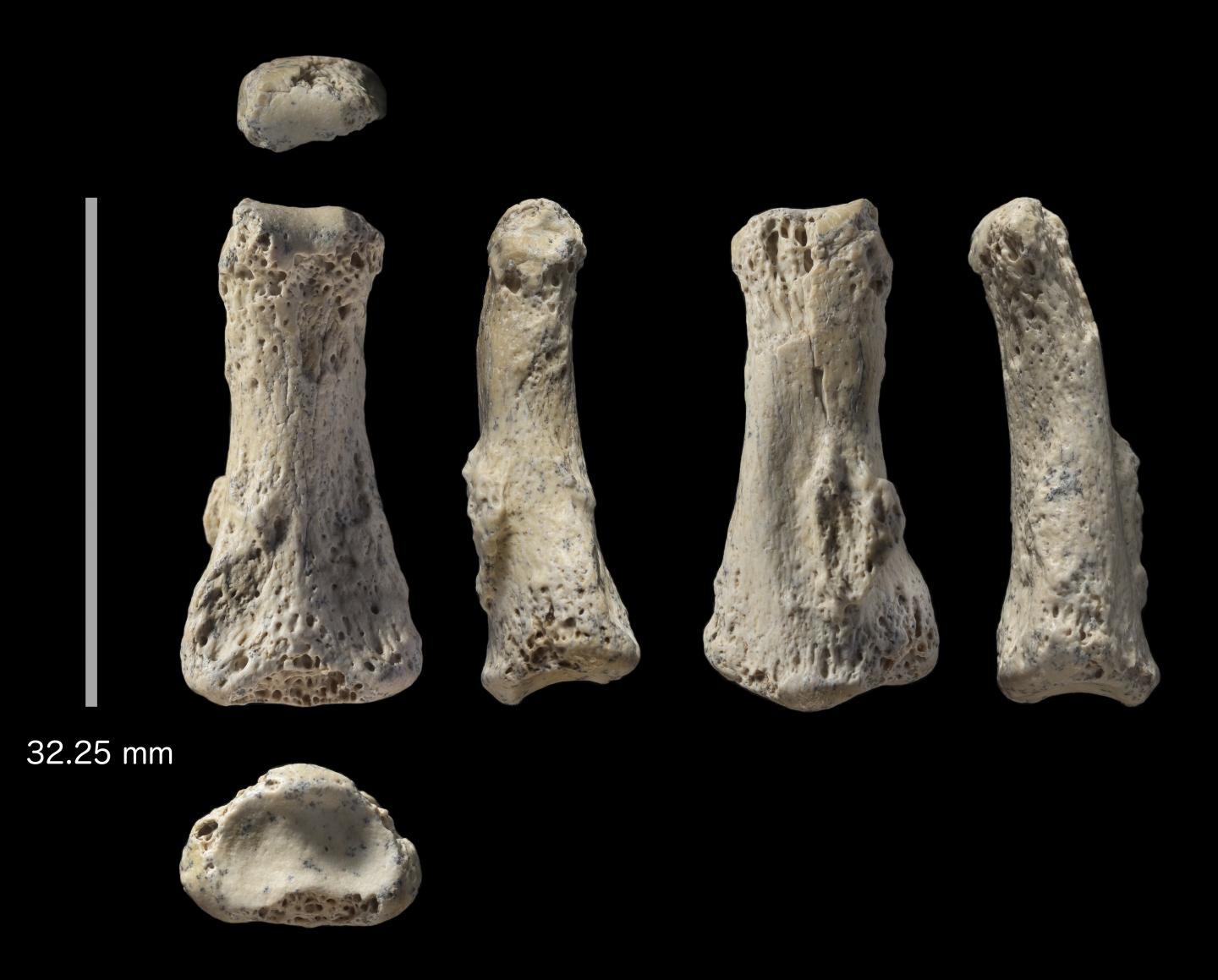
MAX PLANCK INSTITUTE FOR THE SCIENCE OF HUMAN HISTORY—A project led by the Max Planck Institute for the Science of Human History has discovered a fossilized finger bone of an early modern human in the Nefud Desert of Saudi Arabia, dating to approximately 90,000 years ago. The discovery, described in Nature Ecology and Evolution, is the oldest directly dated Homo sapiens fossil outside of Africa and the Levant and indicates that early dispersals into Eurasia were more expansive than previously thought.
Researchers conducting archaeological fieldwork in the Nefud Desert of Saudi Arabia have discovered a fossilized finger bone of an early member of our species, Homo sapiens. The discovery is the oldest directly dated Homo sapiens fossil outside of Africa and the immediately adjacent Levant, and indicates that early dispersals into Eurasia were more expansive than previously thought. Prior to this discovery, it was thought that early dispersals into Eurasia were unsuccessful and remained restricted to the Mediterranean forests of the Levant, on the doorstep of Africa. The finding from the Al Wusta site shows that there were both multiple dispersals out of Africa, and these spread further than previously known.
Oldest directly dated Homo sapiens fossil outside of Africa and the Levant
The results, published in Nature Ecology and Evolution, detail the discovery made at the site of Al Wusta, an ancient fresh-water lake located in what is now the hyper-arid Nefud Desert. Numerous animal fossils, including those of hippopotamus and tiny fresh water snails were found at Al Wusta, as well as abundant stone tools made by humans. Among these finds was a well preserved and small fossil, just 3.2 cm long, which was immediately recognized as a human finger bone. The bone was scanned in three dimensions and its shape compared to various other finger bones, both of recent Homo sapiens individuals and bones from other species of primates and other forms of early humans, such as Neanderthals. The results conclusively showed that the finger bone, the first ancient human fossil found in Arabia, belonged to our own species. Using a technique called uranium series dating, a laser was used to make microscopic holes in the fossil and measure the ratio between tiny traces of radioactive elements. These ratios revealed that the fossil was 88,000 years old. Other dates obtained from associated animals fossils and sediments converged to a date of approximately 90,000 years ago. Further environmental analyses also revealed the site to have been a freshwater lake in an ancient grassland environment far removed from today’s deserts.
Lead author Dr. Huw Groucutt, of the University of Oxford and the Max Planck Institute for the Science of Human History, states, “This discovery for the first time conclusively shows that early members of our species colonized an expansive region of southwest Asia and were not just restricted to the Levant. The ability of these early people to widely colonize this region casts doubt on long held views that early dispersals out of Africa were localized and unsuccessful.”
______________________________
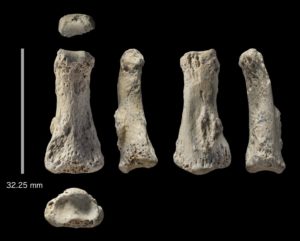
Fossil finger bone of Homo sapiens from the Al Wusta site, Saudi Arabia. Ian Cartwright
________________________________
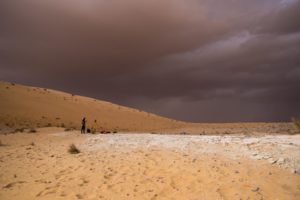
Survey and mapping of the Al Wusta site. Klint Janulis
____________________________
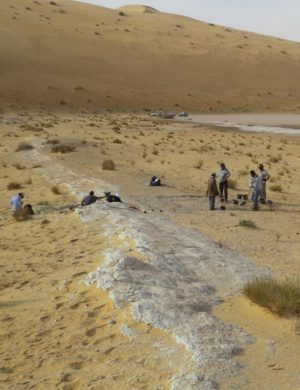
General view of the excavations at the Al Wusta site, Saudi Arabia. The ancient lake bed (in white) is surrounded by sand dunes of the Nefud Desert. Michael Petraglia
Modern deserts of the Arabian Peninsula were once lush grasslands that humans were able to colonize
Project Lead, Professor Michael Petraglia of the Max Planck Institute for the Science of Human History adds, “The Arabian Peninsula has long been considered to be far from the main stage of human evolution. This discovery firmly puts Arabia on the map as a key region for understanding our origins and expansion to the rest of the world. As fieldwork carries on, we continue to make remarkable discoveries in Saudi Arabia.”
The international consortium of researchers involved in this project is headed by the Max Planck Institute for the Science of Human History, in partnership with the Saudi Commission for Tourism and National Heritage. Additional partners include the Saudi Geological Survey, King Saud University, the University of Oxford and other key institutions in the United Kingdom and Australia.
Article Source: MAX PLANCK INSTITUTE FOR THE SCIENCE OF HUMAN HISTORY news release
See the previously published in-depth Popular Archaeology interview with chief scientists conducting research on early humans in Arabia here.
_____________________________
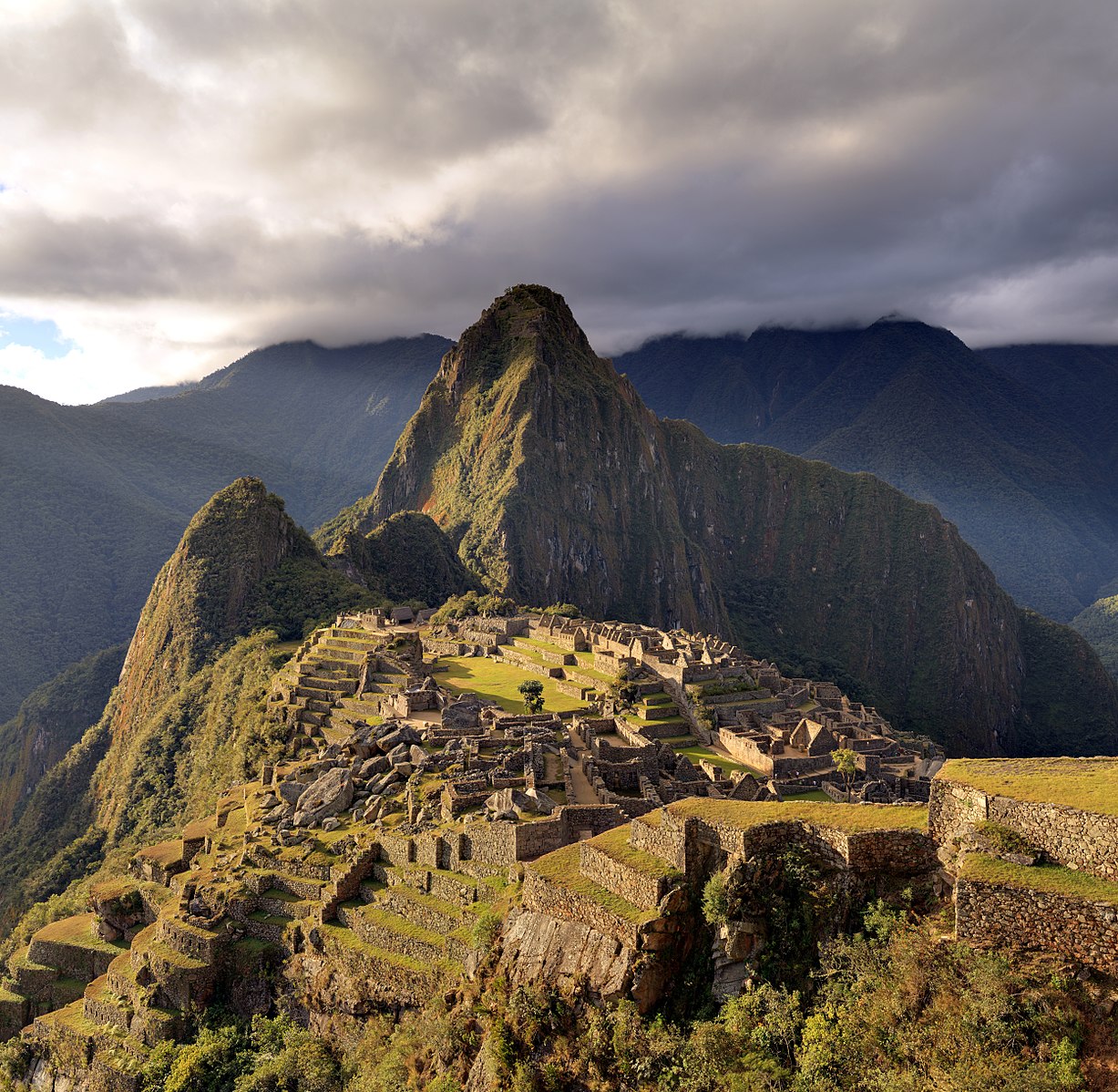
UNIVERSIDAD DE SAN MARTIN DE PORRES–A multinational South American team from Peru, Brasil and Bolivia led by the Universidad de San Martin de Porres at Lima, Peru, published the first genetic study on the modern descendants of the imperial Inca lineages in the journal Molecular Genetics and Genomics. This work supported by funds from the Genographic Project (Geno 2.0), shows new insights about Inca origins and lineages.
The Inka people arrived and in the Cusco valley and in a few centuries they built the Tawantinsuyu, the largest empire in the Americas. The Tawantinsuyu was the cultural climax of 6,000 years of Central Andes civilizations overlapping the modern countries of Peru, Bolivia, Ecuador, the South of Colombia and the North of Argentina and Chile. In contrast with the richness of archeological and cultural evidence, pre Columbian history vanishes in time as it intermingles with myths due to the lack of writing systems before the arrival of the European chroniclers. Very little is known about Inca origins and some genetic information could help reconstruct part of their history. Unfortunately the mummies and bodily remains of the Inca emperors, worshiped as gods, were burned and buried in unknown locations due to religious and political persecution by the Christian conquistadors and inquisitors, so no direct material remains to study their DNA. “Thus for now, only the genetic analysis of modern families of Inca descent could provide some clues about their ancestors” remarks geneticist Jose Sandoval, first author, working at Universidad de San Martin de Porres at Lima, Peru.
There were two foundational myths for the origin of the Incas before they established in Cusco valley to build their capital city. One is that Manco Capac and Mama Ocllo, considered children of the Sun God and founder parents of the civilization, came from Lake Titicaca about 500 km southwards from the border of North Bolivia and South Peru, more or less the same region where the Tiwanaku empire existed a few centuries before. The second myth narrates that four Ayar brothers, with divine powers, came out from the caves inside of a hill in the area of Paccarictambo, 50 km south of Cusco and only one of them, Manco, arrived in the Cusco valley. Concerning the succession of the rulers (between 12 to 14), most chroniclers mention only one patrilineal heritage, however other authors think that it was a complex selection of military and administrative skills not necessarily electing the son of a previous Inca. “A unique patrilineal cluster would be expected in the first case. In the second case, two or more patrilineal patterns will be evident” says geneticist Ricardo Fujita, senior author, also at Universidad de San Martin de Porres”. The research team included historian Ronald Elward, who studied documentation of twelve Inca noble families and followed up from the conquista times to their contemporary descendants. “Most of them still living in the towns of San Sebastian and San Jeronimo, Cusco, Peru, at present, are probably the most homogeneous group of Inca lineage” says Elward.
Markers for Y chromosome and mtDNA were used for the genetic analysis of these families and compared with a database for 2400 native individuals from Peru, Bolivia, Ecuador and Brazil. “The results show distinctive patrilineal origins to two founder individuals who lived between 1000 to 1500 AD, a period between the decline of former Tiwanaku (south) and Wari (north) contemporary empires, and the rise of the Inca empire a few centuries later” says geneticist Fabricio Santos from the Universidad Federal de Minas Gerais at Belo Horizonte, Brazil. The first patrilineal haplotype named AWKI-1 (awki means crown prince in quechua language) is found in the putative families descending from 2 earlier Incas Yahuar Huacac and Viracocha. The same pattern of the Inca descendants was also found in individuals living south to Cusco, mainly in Aymaras of Peru and Bolivia. The second patrilineal haplotype named AWKI-2 was found in one descendant of a more recent Inca, Huayna Capac, father of the two brothers (Huascar and Atahualpa) who were fighting a fraternal war over the empire at the arrival of the conquistadors. “AWKI-2 is also found in dozens of individuals from different locations in the Andes and occasionally in the Amazon, suggesting a populational expansion” says Dr. Santos.
“In addition to San Sebastian and San Jeronimo, most locations of AWKI-1, AWKI-2 were southwards to Cusco including the basin of lake Titicaca and neighboring Paccarictambo, in agreement with the two foundational myths of the Incas” says Ricardo Fujita, “probably two pictures at different times of the same journey with final destination Cusco” adds Fujita. “It is also remarkable that in these contemporary Inca nobility families there is a continuity since pre-Columbian times” says Ronald Elward. The analysis of their mtDNA suggested a highly varied matrilineal marker whose counterparts are found all over the Andes reflecting a high genetic flow. “This probably reflects the political alliances by arranged marriages between Cusco nobility and daughters of lords of kingdoms and chiefdoms all over the empire” states Jose Sandoval.
This work is the continuation of several studies performed by the team to reconstruct South American history by genetics and also funded by a previous grant of the Genographic Project(Geno 1.0) led in South America by Fabricio Santos. Two published works included the unique ancient roots of the Uros, people from the Floating Islands of the Lake Titicaca and the Quechwa-Lamistas in Peruvian Amazon. Modern Uros are Aymara speaking people that some have thought to be people from the Aymara ethnia who profited tourism by living on the floating islands. However the team showed that they were genetically isolated people who had lost their original Uro language, shifting to the more widely used Aymara language. On the other hand the Kechwa-Lamista are Amazonian people who speak the Andean Quechua language and they were presumed descendants of Andeans Chancas, former enemies of the Incas, and were chased by them towards the Amazon. DNA showed that they are actually descendants of linguistically different Amazonian people who were gathered by Catholic missions and were taught the Quechua language (learn by the missionaries at the Andes) for a better evangelization.
“In some cases Genetics shows us something different than the official history. What is not written or badly written in historical records, can be revealed by what is written in our DNA. ” concludes Ricardo Fujita. “This study is just the tip of the iceberg in trying to solve part of several enigmas of one of the most remarkable civilizations. The DNA of one Inca monarch’s bodily remains or of one direct descendant who lived at the beginning of the Spanish colonization could give more certainty about the Inca lineage, and our team is looking forward to it” declares Jose Sandoval.
Article Source: UNIVERSIDAD DE SAN MARTIN DE PORRES news release
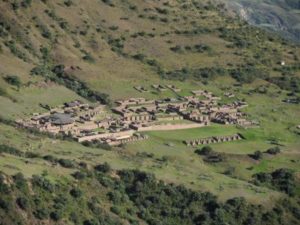
Above: Ruins of temples in Maukallacta in the district of Paccarictambo at about 50 km south Cusco, built by the Incas to honor their ancestors. One of the probable intermediate origins of the Inca lineage in the journey to Cusco. Ricardo Fujita

Above: Machu Picchu, perhaps the best-known ancient site of the Incas. Martin St-Amant
Dr. Steven Ortiz is a biblical archaeologist with over 30 years of field experience and has traveled extensively throughout the Middle East. He is currently the co-director and principal investigator at Tel Gezer. His expertise is the use of archaeology to reconstruct the history of ancient Israel and the Second Temple Period (New Testament). His research focus is the archaeology of the southern Levant. He is active in professional academic organizations and is a prolific lecturer and author. Dr. Ortiz has contributed to several books and monographs: History of Ancient Israel, Do Historical Matters Matter to Faith?, Critical Issues in Early Israelite History, Buried Hopes or Risen Savior, Archaeological and Historical Studies in honor of Amihai Mazar, and The Future of Biblical Archaeology. He is currently working on the publications of Tel Gezer as well as a book entitled Intersections of Archaeology and Biblical Interpretation.
Dr. Samuel Wolff earned his Ph.D. at the University of Chicago in 1986, and has been with the Israel Antiquities Authority since 1991. In addition to his current project at Tel Gezer, Dr. Wolff has also directed excavations at Tel Megadim, En Haggit and Tel Hamid. He is the author of numerous scientific articles and reports related to the archaeology of Israel.

A preliminary summary report of the excavations of a city that, according to the biblical account, was fortified by King Solomon during the time of the United Monarchy of ancient Israel . . .
This article is available to Premium members of Popular Archaeology.
Become a member or upgrade to a Premium membership: REGISTER HERE.
Member Login:
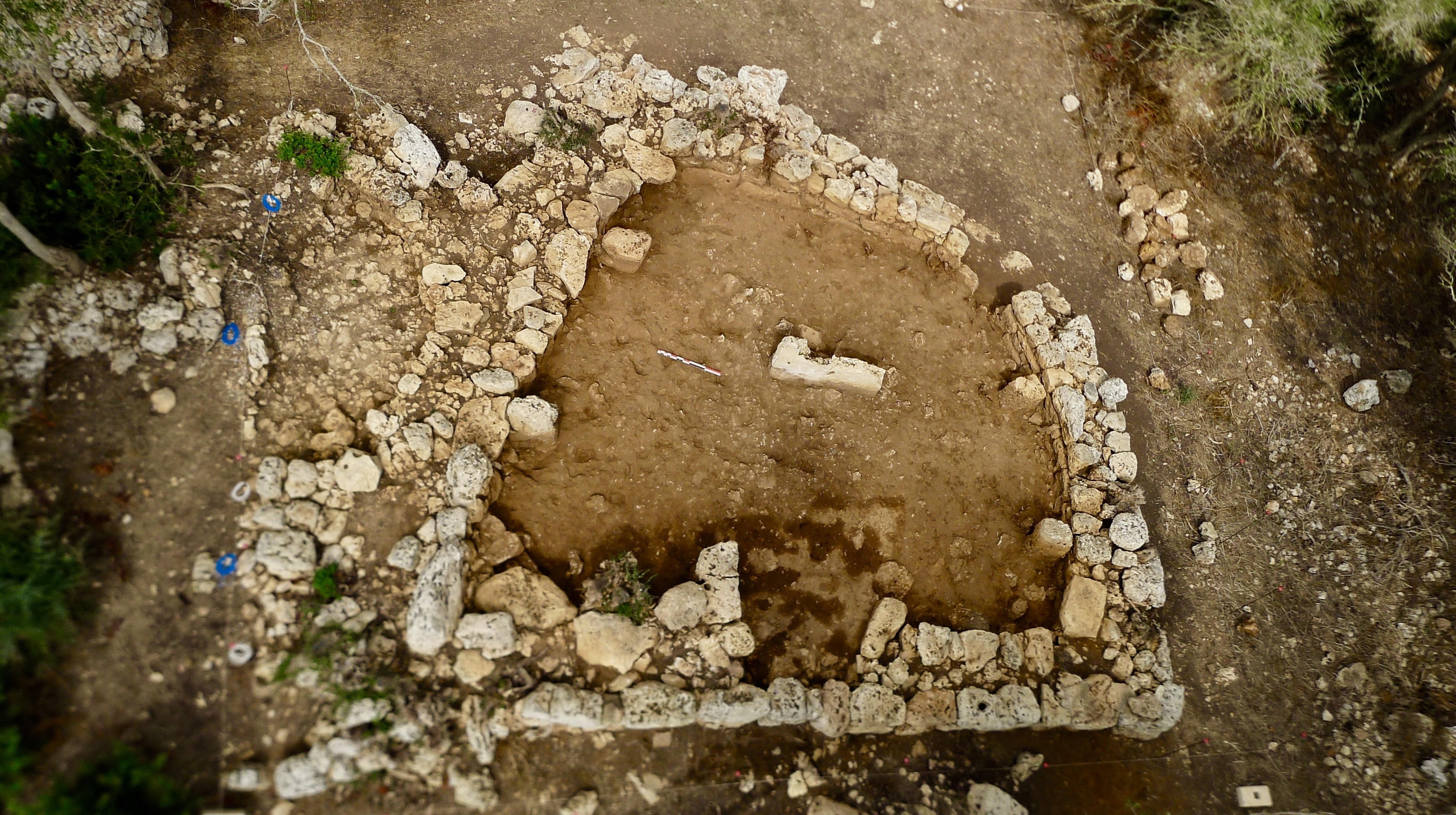
In 2015 a team of archaeologists founded the Sa Cudia Cremada Archaeology Field School, currently focussing on the excavation and study of the prehistoric sanctuary located at the Talayotic site of Sa Cudia Cremada (on Menorca, in the Balearic Islands). After three excavation seasons (the fourth to take place in September 2018), the team has confirmed the discovery of a remarkable taula enclosure, including evidence about its chronology and some of the most typical elements that can be found in these building types.
________________________________
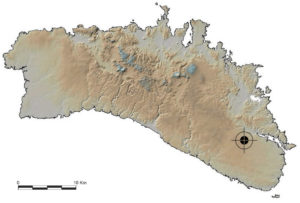
Location of Sa Cudia Cremada at the eastern side of Menorca. Sa Cudia Cremada Archaeology Field School
_________________________________
So what is“Talayotic” and a “taula enclosure”?
Talayotic is the name given to the period roughly beginning around 1200 BC in the Late Bronze Age, characterized by a great social change in the Balearic Islands of Menorca and Mallorca, which was reflected, among other features, in a more complex and stratified social system and a new organization based in settlements that had little or nothing to do with previous settlements. These new villages, known as Talayotic settlements, had at least one talayot — a public tower-shaped structure that could exhibit different shapes and sizes. During prehistoric times, the island of Menorca shared many aspects with its neighbour Mallorca, including the Talayotic culture itself and the construction of talayots. However, both islands had significant differences that can be seen in their respective material cultures and architectural types. In this way, for instance, despite the fact that both islands had talayots, broadly speaking those in Menorca are probably slightly older and, in terms of morphology, larger and presenting several layouts and sizes, whereas the Mallorcan talayots are standardized towers with either a rounded or squared-shaped layout and an internal chamber with a central column. Even though some Minorcan talayots do have an internal chamber with a central column, most of them are solid structures, whose active areas were located at their top platform, which suggests a control of the surrounding territory by those using it, as well as a means for communication purposes with nearby settlements.
The Talayotic period lasted approximately until 500 BC, and the subsequent period is known either as Late Talayotic or Post-talayotic by prehistorians and archaeologists. This new phase within the prehistory of Menorca is characterized by new changes in the society, including a more intense commerce with foreign cultures, especially with the Punics, with whom they traded a variety of products during much of the second Iron Age. During this period, Talayotic settlements experienced several changes, such as the abandonment of talayots, or at least the loss of their primary functions. This period also witnessed the construction and use of new buildings and other structures, such as outer walls, circular-layout houses with an internal courtyard, hypostyle halls and a new public structure type: the taula enclosure. What were these latter enclosures? Archaeologists suggest that they were religious spaces where in certain times of the year the Late Talayotic communities performed their rituals, likely connected to the different stages of the agricultural cycle. These buildings can be found neither in Mallorca nor in other parts of the world and this fact, along with their monumentality, makes them a unique example of monumental prehistoric religious architecture.
Despite the fact that they can present several variations in size and internal elements, all of them are characterized by a horseshoe-shaped layout with a rectilinear façade facing south, a set of pilasters that abut the internal face of the wall and a central monument called the taula, which means table in Catalan, the native language spoken in Menorca. The name was given by Minorcan people long ago, as these monuments resemble big tables that, according to mythical stories and legends, were used by giants who lived on the island. Despite their monumentality and dimensions, we now know that taulas were not tables at all, but symbolic elements erected by men. A taula consists of two large stone slabs that form a T-shaped structure, constructed without mortar and reaching up to 5 meters high and 22 tons, as is the case of the largest one, located in Torralba d’en Salort.
Thus far, more than 30 taula enclosures have been documented on the island, some of which are well preserved with most of their elements in situ, including the taulas themselves. Of those, several were excavated in the 20th century, and the results of these excavations were of high importance in terms of determining their religious function and the practices carried out within them during the Late Talayotic period. In fact, the first scientific excavation project taking place on Menorca had the main aim of excavating a taula enclosure, which was carried out by British archaeologist Margaret A. Murray in the 1930’s. First, Murray directed the excavation of the taula enclosure at the settlement of Trepucó and, a few years later, she also excavated the one at the site of sa Torreta de Tramuntana. In both she found evidence of rituals involving the consumption of food (mainly meat from sheep, goats and pigs) and wine, as well as both native and imported materials, including religious elements such as incense burners depicting Tanit, the Punic goddess of fertility. The ritualistic aspects of these buildings were also attested in the other taula enclosures excavated on the island, including those at Torre d’en Galmés, Binissafullet and Torralba d’en Salort, the latter one being the most stunning example for its high state of preservation, monumentality and dimensions.
Even though we currently have relevant information about these buildings, there is still a lot to do in order to fully understand their chronological, ritualistic and architectural aspects. In this way, in 2015 the excavation of the sanctuary of Sa Cudia Cremada began with the primary objective of finding evidence that could help the team determine the phases of construction, occupation and abandonment of these buildings (through both typological studies of artifacts and a variety of analyses on some remains); the meaning of the rituals performed and the deities worshipped inside; and architecture-related aspects such as the existence or absence of a roof covering the internal space of these enclosures, something that is still under debate among archaeologists working on the island.
_______________________________
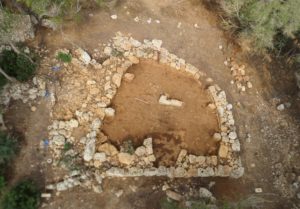
Aerial view of the taula sanctuary of Sa Cudia Cremada at the end of 2016 season. Sa Cudia Cremada Archaeology Field School
_______________________________
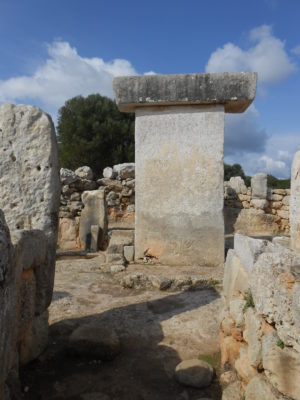
The most stunning example of a taula enclosure: Torralba d’en Salort, which was excavated in 1970’s. This also shows example of a T-shaped stone structure. Sa Cudia Cremada Archaeology Field School
________________________________
The Excavations
With these aims in mind, along with an international field school to deliver high-quality training in archaeological practice (giving students the chance to dig and learn at a unique site), the taula enclosure of Sa Cudia Cremada began to be excavated. After the 2015, 2016 and 2017 seasons, the team has already gathered relevant data on some of these aspects and, without any doubt, the following seasons will continue to shed light on the religious aspects of this unique Mediterranean society. The excavation of this taula enclosure aims to add more information about these buildings by using new methodologies and technologies that did not exist at the beginning and middle of the 20th century, when most of the other taula enclosures were excavated. We can now employ new methods of radiocarbon dating of organic materials as well as analyze the pollen present in the soil we excavate, among other micro-remains, all of them leading to new possibilities such as narrowing the chronologies of the building down with absolute dating and reconstructing the paleoenvironment of the site.
The team and the students who have attended the summer courses in the past three years have uncovered roughly half of the building and, in doing so, its total layout is now exposed, which is horseshoe-shaped and oriented to the South. Also, its main internal features have already been located, including its taula monument, which stands, as expected, in a central position. This taula monument preserves its vertical stone, whereas the lintel that once rested on it is now lost. The vertical stone, however, is still in its original upright position and is flanked on one side by a rectangular stone. Also, a set of pilasters abutting the internal face of the wall have been located, surrounding the taula.
All elements have been uncovered by removing several deposits that overlaid the building and also within, including a significant level composed of a large quantity of tumble stones from the walls. All artifacts recovered so far were located in this and other levels, most of them dating from the Late Talayotic period or second Iron Age. Among these materials, the most abundant is pottery, followed by a remarkable quantity of faunal remains and, in lesser amounts, lithic, bone and metal objects. The pottery assemblage is typical of these contexts and includes a large number of amphorae, most of them originating in Punic Ibiza, followed by amphorae from the eastern coast of the Iberian Peninsula. Also, both native and imported table wares, including cups, jars and storage containers, have been located. Both amphorae and table wares roughly date from the 4th to the 2nd centuries BC, with very few pieces dated to more recent dates. Regarding the faunal remains, most of the bones belonged to sheep, goats and pigs and feature cut marks. Even though these materials, along with those that will be found in future seasons, have to be thoroughly analyzed, we can already state that they define the typical assemblage of artifacts and eco-facts found in a taula enclosure, and most probably suggest the same ritualistic purposes thought to be associated with the other taula sanctuaries previously excavated on the island.
_________________________________
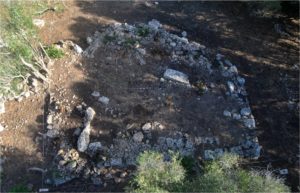
Aerial view of the taula sanctuary of Sa Cudia Cremada before the start of the first excavation season in 2015. Sa Cudia Cremada Archaeology Field School
_______________________________
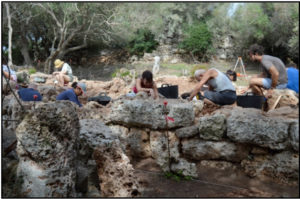
Working shot during fieldwork. Sa Cudia Cremada Archaeology Field School
_______________________________
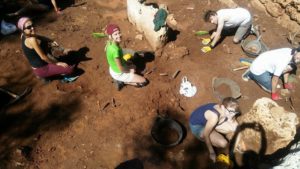
Working with the students in September 2017. Sa Cudia Cremada Archaeology Field School
_________________________________
The Promise of Sa Cudia Cremada
The prehistoric archaeology of Menorca is unique, and researching its archaeological sites has helped to gain more valuable information about the society that thrived and died out on the island during the Talayotic period before the arrival of the Romans at the end of the 2nd century BC. The Talayotic archaeological heritage is currently nominated to World Heritage status by UNESCO, a recognition that would contribute to the dissemination and wider recognition of this amazing heritage, a culture still not very well known outside the Balearics. So far, participants from the USA, Australia, Hong Kong, Netherlands, Belgium, UK and Canada, among other countries, have attended the courses organized by the field school, where they have learned about excavation methodology while applying this knowledge during fieldwork at the site’s taula enclosure. But apart from gaining fieldwork and post-excavation experience, students have discovered an incredibly well preserved prehistoric heritage on a small paradisiac Mediterranean island. All of them have left Menorca feeling touched by the Talayotic culture. By exposing international students to this archaeology we ensure it will be known and respected not only on the island, but also throughout the world. We hope to continue to welcome new students who will learn with the team about archaeological practice while they discover this unique heritage.
For more information about the project, please visit the website: http://archaeologysacudia.com/en/. The registration period for the 2018 season is now open!
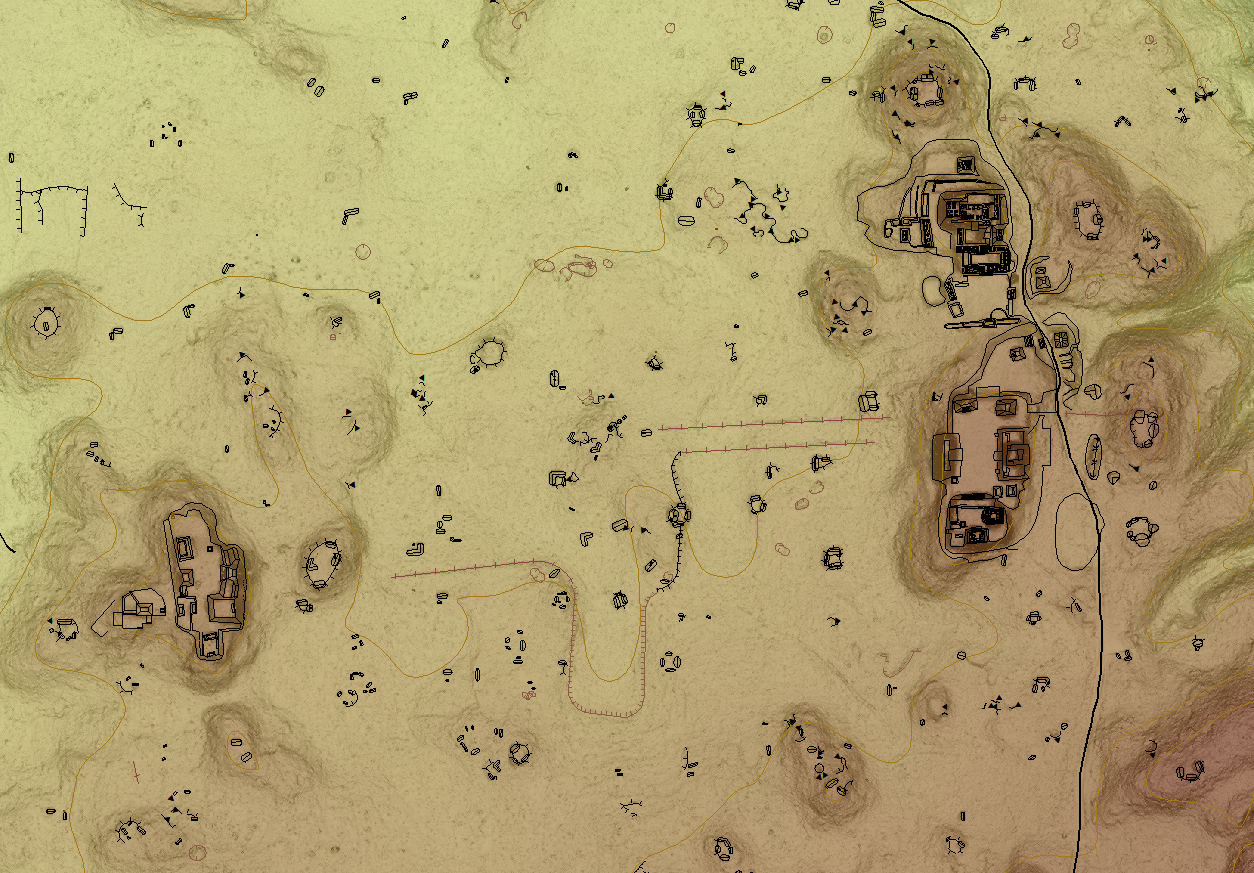
Sensationalized for seeing through the forest canopy, touted for its remarkable imagery that maps the forest floor, LiDAR* — the remarkable new laser technology that helps us “see” the unseen — has captured the attention of the public even as the Maya forest still keeps many of its secrets. The recent news of the extensive LiDAR coverage of the Reserva de la Biosfera Maya in Guatemala represents an important step in uncovering the nature of the ancient Maya landscape — revealing the topographic reality of the forest floor. But the Guatemala coverage is not the first LiDAR look into archaeology under the canopy. This publicized coverage was already matched in western Belize, first for the area associated with the ancient Maya city of Caracol in the south, over-flown in 2009, then the area of El Pilar, an ancient Maya city located on the border between Belize and Guatemala in 2012, followed by a major swath of 1057 km2 of the Belize Valley in 2013. All combined, now the LiDAR surveys of the central Maya lowlands makes for an amazing source for new research on the Maya environment and settlement. And as a resource, it is clear that the lab work in the context of the GIS and field work with the GPS to validate these data will take decades. Combining the Belize and Guatemala LiDAR coverages, we have a total area of some 3000 km2, embracing northern Guatemala and western Belize, the core area of Classic Maya civilization (Figure 1 ).
*Light Detection and Ranging, a remote sensing method that uses light in the form of a pulsed laser to measure ranges, or variable distances, to the Earth, often employed by aircraft
______________________________
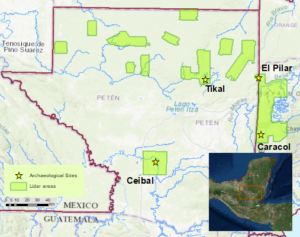
Fig. 1: Regional view of LiDAR coverage for the Maya area. BRASS/El Pilar
_______________________________
We now have the ability to identify every major Maya monument, what we call the “big stuff.” This includes a mysterious “Citadel,” the hilltop temple-plaza complex surrounded by rampart and earthworks to the east of the core of El Pilar.
The El Pilar Experience
We have been working with LiDAR coverage for four years at the El Pilar Archaeological Reserve for Maya Flora and Fauna. We find LiDAR technology to be a magnificent tool (Figure 2). The data on topography alone is astounding, and we can interpret variations in elevations to 1 m with tracking details of the ground. BUT: LiDAR is not a magic wand. There is a vital need to use ground-truth procedures and validate interpretations from LiDAR by archaeologists in the field.
______________________________
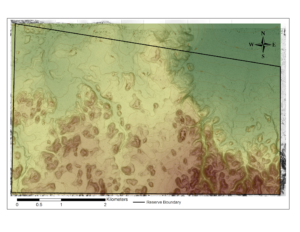
Fig. 2: El Pilar Archaeological Reserve LiDAR : Bonemap visualization with “big stuff” dramatically visible. BRASS/El Pilar
_______________________________
The El Pilar LiDAR coverage of a 20 km2 area straddles Belize and Guatemala (Figure 3). We initially examined the major monuments. They were startlingly clear! It is the small structures as well as related cultural features — the depressions, terraces, and quarries — that are subtle, requiring care in the relationship of the visual rendering of the LiDAR and the field mapping details. We began in the lab using the GIS and our bone-mapping visualization to identify the elements that were potentially cultural remains — we call these our “GoTo” points (Figure 4). We have field-verified our lab identifications, validating all features within a 10 km2 area. We have field-investigated the areas immediately surrounding the Late Classic core of El Pilar where we had mapped in 2000 and 2001. We have covered an area in the NE with few identified features and in the NW where there were many features. We have field-validated 1,214 points in total (Figure 5). We have found that an average of 83% of our points of interest result in cultural features on the ground, but only 611, or 50% are attributed to structures and mapped as residential units of the ancient Maya people.
_____________________________
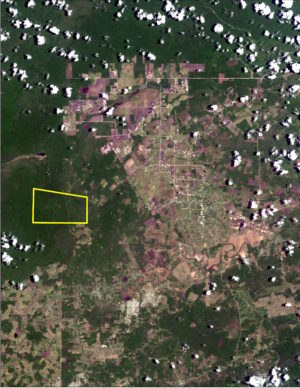
Fig. 3: Location of the El Pilar Archaeological Reserve for Maya Flora and Fauna indicated with a yellow polygon on Landsat 8 imagery. BRASS/El Pilar
____________________________
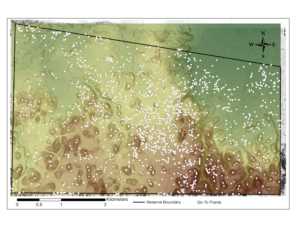
Fig. 4: El Pilar “GoTo” points for the 20 km2 survey area. BRASS/El Pilar
______________________________
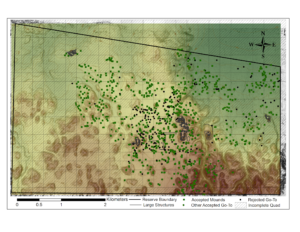
Fig. 5: The visited “GoTo” points in surveyed 10 km2 area with green = accepted and black = rejected. BRASS/El Pilar
_______________________________
There is considerable variability across space related to the way the ancient Maya used the landscape. Our predictive model shows that the Maya preferred well drained areas and our surveys at El Pilar support this. The NE area of the El Pilar Archaeological Reserve is a transitional wetland. There, we tabulated very few elements: less than 20/km2. Our question was: Does this lab review in the context of the GIS square with our field investigations? With so few targets for our “GoTo” points, we determined that this area warranted a full coverage survey to test the accuracy of the LiDAR.
In 2016, we were able to verify the truth of the LiDAR imagery in the field by validating the few cultural remains in the area. We recorded 106 features, including 80 residential units. This result gave us confidence in our expectations and in the LiDAR visualizations. The majority of the sites were located in the higher southern portion of the survey. This area rises out of the wetlands and is near Chorro, a minor center not far from El Pilar. Many of our “GoTo” points we started with in this area were rejected, attributed to the debris of nuts and dead fronds that accumulate beneath the magnificent Atelea cohune palms. We found some unusual linear features based on our field survey in the wetland zones that were not visible in LiDAR visualizations. As unusual alignments, these features along contours are perhaps related to water control. But such features, while not domestic architecture, could be something else.
In the visualization of the NW area of the reserve, we identified many large rectangular features in the LiDAR images. There were approximately 60 “GoTo” points per km2, three times the number of the NE area. Most of these points revealed major cultural features, and along the way we mapped quarries, depressions, terraces, berms, and chultunes, that are not reliably visible with the LiDAR but are important land use features. We mapped 150 residential units in the 2017 survey, nearly twice as many as the NE area. We found that few of our points were rejected as natural features compared to the NE. Most common natural features were large tree buttresses, like the amate trees.
____________________________
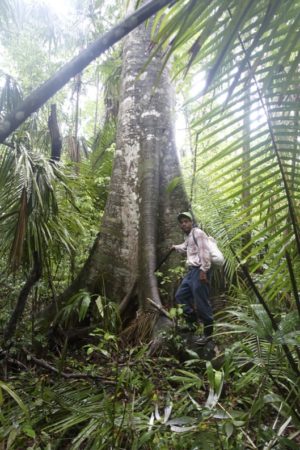
Fig. 6: Buttressed amate tree with Jerry Waight as scale. BRASS/El Pilar
____________________________
We expected major architectural features based on the LiDAR, and we were not disappointed. We mapped large plazas, over 100 m in length, temples higher than 11 m, even platforms over 25 m long. We noted that the major architecture followed ridges that flanked an arroyo. By the conclusion of the survey, three monumental areas were mapped among the residential units. These minor centers were located within 2 km of the El Pilar core. We named them: OxTeXik, east of the arroyo; Amatal, west of the arroyo; and Kum, to the north.
The Significance of the El Pilar Surveys
We have learned much about the relationship between the landscape and the LiDAR-based visualization over the course of our four years of field validation. It is important that we have collected data on the visualizations and the validation of cultural features. Although not all suspicious features are accepted in the field, LiDAR is a great tool for directing the “boots on the ground.”
We are now dedicated to the long process of learning how the vast potential of LiDAR can be integrated into our archaeological tool kit. Clearly an asset, LiDAR increases our capacity to understand the importance of the landscape and in interpreting settlement patterns. We now can hypothesize specifically on the nature of ancient land use. We can also appreciate the variability in the types of cultural features revealed by laser technology. This applies both to archaeology generally and the Maya, specifically.
Revealing the Geography
While we are absorbing new aspects about archaeological discovery, we are able to identify the geographic foundation of the surface of the Maya forest as well as distinctions in the forest. The LiDAR coverage allows us to recognize the geography, the ridges and lowlands, the hills and drainage, as well as the water flows. We have to bear in mind that at least 95% of the laser returns collected by the LiDAR technology is attributed to above ground biomass. These data, when used by forest ecologists and resource managers, provide direct information on the state of the forest, its varied heights and relationship to the topography. In fact, with cross sections of the LiDAR point cloud, one can identify actual trees! The forest environmental variability is the key to interpreting ancient Maya settlement, and the density of settlement is the key to understanding the extent of ancient civic centers.
The Takeaways
Comprehending the potential of LiDAR for archaeology in the tropics will be a long process. LiDAR coverage comes with massive amounts of data (Figure7). There is an average of 25 laser returns per m2. This translates into 25,000,000 returns per 1 km2 and these digital data take up a lot of space and are hard to manipulate with the average computer.
______________________________

Fig. 7: Oblique LiDAR view of the El Pilar acropolis and ground points (dark green) and vegetation biomass (light green). BRASS/El Pilar
_______________________________
When contemplating the data sets generated by the reported 1200 km2 coverage in Guatemala, the numbers are astonishing! Thinking that only 5% of the returns are the last returns and are taken to be the ground surface, those numbers come to 1,250,000 per km2! These are the data that we must work with as our starting point. This is before any ground validation is initiated in the field. The reported claims of 60,000 structures, around 30-50 structures/km2, are not startling based on all the traditional settlement transect surveys that reveal dense settlements where there are well drained uplands.**
Ground-truthing in the field is not simply inputing the destination points into the GPS and trekking out to them. Each GPS can record tracks as you course to the destination. In the field, archaeologists record way points with the GPS and they need to be properly identified. Managing all these facets of data collection is a job unto itself. Fundamental data collection protocols must be established. Without a defined protocol, these data quickly become unwieldy. Huge amounts of data are generated from LiDAR lab-to-field projects and care must be taken to ensure their legitimacy.
We have developed and honed our El Pilar protocol for field validating the “GoTo” points generated in the lab, where points are identified on LiDAR visualizations in the context of GIS. Using our Bone mapping visualization strategy, we identify features on the landscape as our field mapping destinations. For the past four years, we have covered 10 km2, validating 1,214 “GoTo” points, mapping 1,335 new cultural features, verifying 611 domestic structures, and mapping 7 civic monumental locales. While visiting our “GoTo” points, we found 16% were not cultural, but natural elements: buttresses of large trees, frond and seed debris from palms, and even “pox” we confirmed as problems inherent in the LiDAR data interpretations. We use our findings with a strict protocol of field-to-lab management. With our experience, we are now in a position to untangle the potentials and the predictions based on LiDAR.
Going Forward
Our confidence in LiDAR grows with our boots on the ground. Our experience is providing a new way of appreciating the nature of the Maya forest and the importance of understanding archaeology under the canopy. Our new Maya Forest Atlas provides one with a unique view of scale, featuring our El Pilar LiDAR at the site scale, geographic data at the local scale of the Belize River, and regional scale views of the entire Maya forest. These data will be updated as we work to complete the validation for the remaining 10 km2 of the El Pilar Archaeological Reserve for Maya Flora and Fauna.
LiDAR is no magic wand. Yet our survey efforts are well informed and greatly advantaged by the technological contribution of LiDAR. We know there is much work to do and we can see that our work at El Pilar will be a solid basis for the hard work that Maya archaeological surveyors will be undertaking into the future.
_____________________________
*Light Detection and Ranging, a remote sensing method that uses light in the form of a pulsed laser to measure ranges, or variable distances, to the Earth, often employed by aircraft
**The Maya Forest Garden: Eight Millennia of Sustainable Cultivation of the Tropical Woodlands by Anabel Ford and Ronald Nigh
Article Cover Image: Architecture revealed in the El Pilar area with the help of LiDAR. BRASS/El Pilar
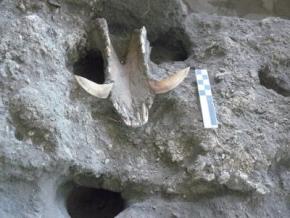
PROCEEDINGS OF THE NATIONAL ACADEMY OF SCIENCES (PNAS)—Researchers report* evidence for the early spread of agriculture into central Anatolia. The means by which agriculture expanded beyond the Fertile Crescent of Southwest Asia, where agriculture originated in the 10th and 9th millennia BC, is unclear. Douglas Baird and colleagues report a wide range of archaeological evidence of agriculture from the 10th-millenium and 9th-millennium sites of P?narba?? and Boncuklu on the Central Anatolian plateau in Turkey. At Boncuklu, the presence of macrofossils and phytoliths of wheat chaff, along with seeds of agricultural weeds commonly found in early farming sites, suggest the cultivation of crops, and the nitrogen isotope compositions of sheep and goat remains indicate a dietary signature that suggests small-scale experimentation with herding of these animals. By contrast, P?narba?? exhibited none of the evidence of crop cultivation found at Boncuklu. Analysis of stone tools and ancient DNA from both sites suggest that the inhabitants represented an indigenous population, rather than migrants from earlier agricultural communities to the south and east. According to the authors, the findings suggest that indigenous people adopted cultivation and herding only on a small scale, probably not for economic reasons, but some communities like P?narba?? resisted the adoption of agriculture altogether. Hence, the spread of agriculture was not uniform throughout the region, according to the authors.
__________________________________
A boar jaw inserted into a niche in the wall of a Neolithic house at Boncuklu, Turkey. PNAS
_____________________________________________
Incised stone plaque from Boncuklu, Turkey. PNAS
___________________________________
Shell beads that formed a necklace, from a Neolithic house burial at Boncuklu, Turkey. PNAS
__________________________________
Article Source: PNAS news release
*Article: “Agricultural origins on the Anatolian plateau,” by Douglas Baird et al.
_____________________________________________
Become a new Popular Archaeology premium subscriber.
___________________________________________
Travel and learn with Far Horizons.
______
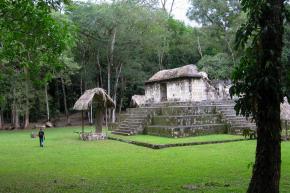
SMITHSONIAN TROPICAL RESEARCH INSTITUTE—Police detectives analyze isotopes in human hair to find out where a murder victim was born and grew up. Ashley Sharpe, an archaeologist at the Smithsonian Tropical Research Institute in Panama, and colleagues combined clues from carbon, nitrogen, oxygen and strontium isotope analysis discovering the earliest evidence that the Maya raised and traded dogs and other animals, probably for ceremonial use.
Their results are published in the Proceedings of the National Academy of Sciences during the week of March 19.
“In Asia, Africa and Europe, animal management went hand-in-hand with the development of cities,” said Sharpe. “But in the Americas people may have raised animals for ceremonial purposes. The growth of cities doesn’t seem to be directly tied to animal husbandry.”
Sharpe found that animal trade and management began in the Preclassic Period some 2,500 years ago and intensified during the Classic Period, making it likely that organized ceremonies involving animal and human sacrifice and raising animals for food played important roles in the development of Maya civilization.
Isotopes are atoms that have the same number of protons and electrons but different numbers of neutrons and therefore have different physical properties. For example, carbon has two stable isotopes: carbon 12 with six protons and six neutrons and carbon 13 with six protons and seven neutrons. Carbon in animals’ bodies comes from the plant tissues they consume directly or indirectly. Most plants use the most common type of photosynthesis to turn carbon dioxide into carbohydrates. This process leaves mostly the lighter carbon isotope, carbon 12, behind, bound up in carbohydrate molecules. Corn, sugar cane and other grasses use another type of photosynthesis that concentrates heavier, carbon 13 molecules. Nitrogen isotopes in proteins demonstrate a similar pattern.
Sharpe and colleagues analyzed the isotopes in animal remains from Ceibal, Guatemala, a Maya site with one of the longest histories of continuous occupation, and one of the earliest ceremonial sites. Most of the bones and teeth they tested were from the Maya Middle Preclassic period (700-350 B.C.).
“The animal remains fall into two categories, those with lower carbon isotopes, indicating they were eating mostly wild plants, and those with higher isotopes, which were probably eating corn.”
All of the dogs, two northern turkeys, Meleagris gallopavo, the turkey species that was eventually domesticated, and one of two large cats were probably eating corn or other animals that fed on corn, such as a peccary (wild pig).
Because people in the region often killed animals that came into gardens and areas where crops were being cultivated, it is possible that peccaries and turkeys may also have been eating crop plants, but it is likely that turkeys were managed by the end of the Classic Period.
Deer bones showed butcher marks, but they were hunted from the forest, not domesticated according to isotope analysis of bones that also had lower carbon isotopes.
One large cat and a smaller cat, probably a margay, Leopardus wiedii, had lower carbon isotopes indicating that they ate animals that fed on wild plants.
The ratio of two strontium isotopes reflects the local geology in a region. Forty-four of the 46 animals had strontium isotope ratios matching Ceibal and the surrounding southern lowlands region. However, to Sharpe’s surprise, jaw bones from two dogs excavated from deep pits at the heart of the ancient ceremonial complex had strontium isotope ratios matching drier, mountainous regions near present-day Guatemala City. “This is the first evidence from the Americas of dogs being moved around the landscape,” Sharpe said. “Around 1000 A.D. there’s evidence that dogs were moved out to islands in the Caribbean, but the Ceibal remains are dated at about 400 B.C.” Part of the jaw bone and teeth of a big cat was found with one of the dogs in the same deposit.
“The interesting thing is that this big cat was local, but possibly not wild,” Sharpe said. “Based on its tooth enamel, it had been eating a diet similar to that of the dogs since it was very young. Perhaps it was captured and raised in captivity, or it lived near villages and ate animals that were feeding on corn. We still have to look at the DNA to figure out if it was a jaguar or a puma.”
Sharpe is looking forward to understanding more about the context of these finds. “The results in this publication are based on excavations we did in 2012. My colleagues at the Ceibal-Petexbatun Archaeological Project will publish additional analyses, and I’m looking forward to finding out if all of the human remains at the site are from the region.”
“It’s interesting to consider whether humans may have had a greater impact managing and manipulating animal species in ancient Mesoamerica than has been believed,” Sharpe said. “Studies like this one are beginning to show that animals played a key role in ceremonies and demonstrations of power, which perhaps drove animal-rearing and trade.”
___________________________________
Ashley Sharpe, staff scientist at the Smithsonian Tropical Research Institute in Panama, found the remains of dogs from the Guatemalan highlands at Ceibal, a lowland site, indicating that the Mayas were moving or trading dogs for ceremonial use. Ashley Sharpe
_______________________________________________
Article Source: Smithsonian Tropical Research Institute news release
_______________________________________________
This study was funded by the National Science Foundation, Sigma Xi Scientific Research Society, University of Florida Latin American Studies Program Tinker Grant, University of Florida Department of Anthropology Charles Fairbanks Award and Alphawood Foundation.
The Smithsonian Tropical Research Institute, headquartered in Panama City, Panama, is a unit of the Smithsonian Institution. The Institute furthers the understanding of tropical biodiversity and its importance to human welfare, trains students to conduct research in the tropics and promotes conservation by increasing public awareness of the beauty and importance of tropical ecosystems. Website. Promo video.
Reference: Sharpe, A.E., Emery, K.F., Inomata, T. et al. 2018. Earliest isotopic evidence in the Maya region for animal management and long-distance trade at the site of Ceibal, Guatemala. PNAS. Doi: 10.1073/pnas.1713880115
_______________________________________________________
Become a new Popular Archaeology premium subscriber.
___________________________________________
Travel and learn with Far Horizons.
______
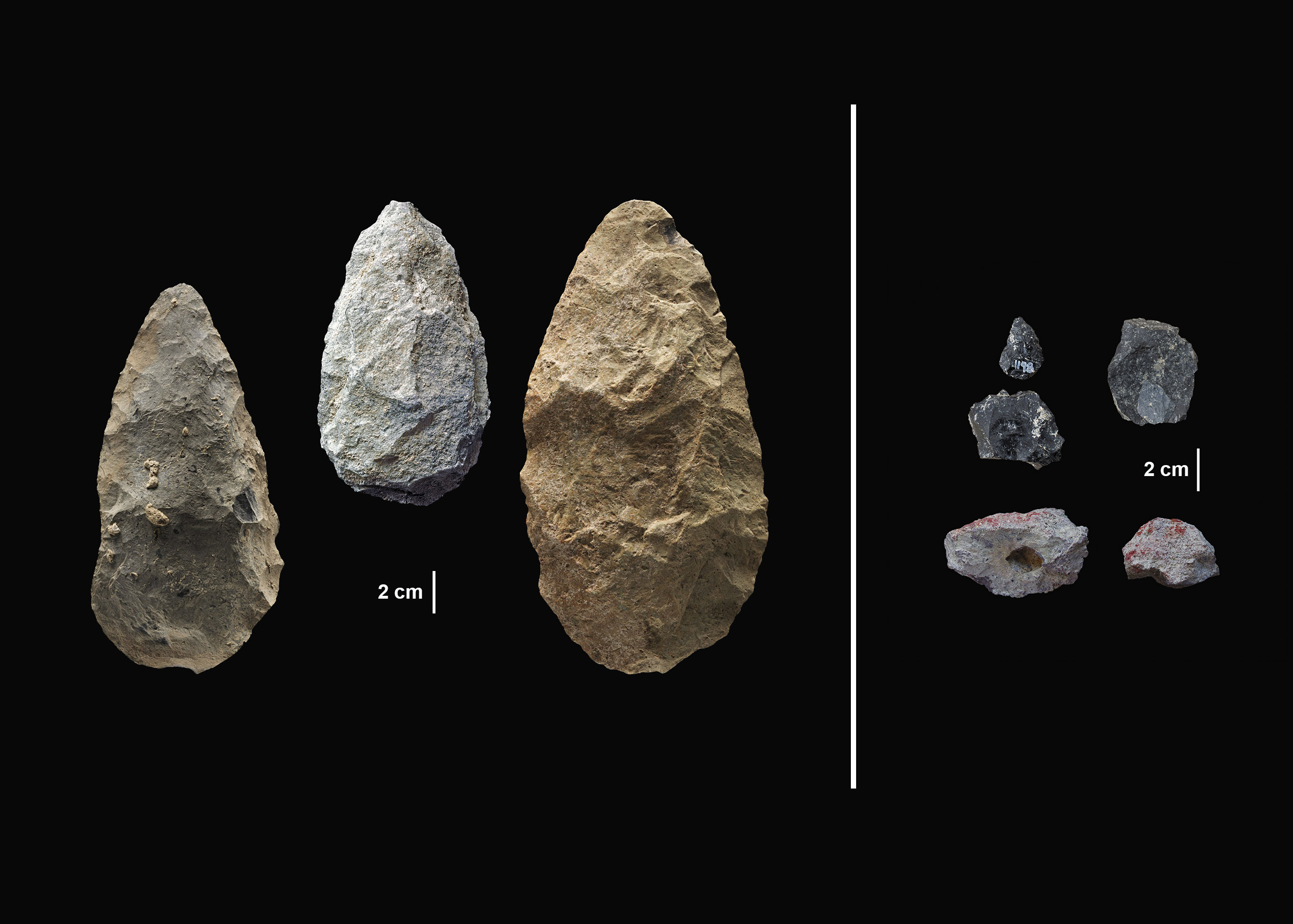
This article is available to Premium members of Popular Archaeology.
Become a member or upgrade to a Premium membership: REGISTER HERE.
Member Login:
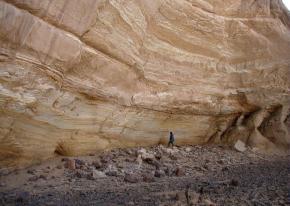
UNIVERSITY OF HUDDERSFIELD—By analyzing a prehistoric site in the Libyan desert, a team of researchers from the universities of Huddersfield, Rome and Modena & Reggio Emilia has been able to establish that people in Saharan Africa were cultivating and storing wild cereals 10,000 years ago. In addition to revelations about early agricultural practices, there could be a lesson for the future, if global warming leads to a necessity for alternative crops.
The importance of the find came together through a well-established official collaboration between the University of Huddersfield and the University of Modena & Reggio Emilia.
The team has been investigating findings from an ancient rock shelter at a site named Takarkori in south-western Libya. It is desert now, but earlier in the Holocene age[our present age], some 10,000 years ago, it was part of the “green Sahara” and wild cereals grew there. More than 200,000 seeds – in small circular concentrations – were discovered at Takarkori, which showed that hunter-gatherers developed an early form of agriculture by harvesting and storing crops.
But an alternative possibility was that ants, which are capable of moving seeds, had been responsible for the concentrations. Dr Stefano Vanin, the University of Huddersfield’s Reader in Forensic Biology and a leading entomologist in the forensic and archaeological fields, analyzed a large number of samples, now stored at the University of Modena & Reggio Emilia. His observations enabled him to demonstrate that insects were not responsible and this supports the hypothesis of human activity in collection and storage of the seeds.
The investigation at Takarkori provides the first-known evidence of storage and cultivation of cereal seeds in Africa. The site has yielded other key discoveries, including the vestiges of a basket, woven from roots, that could have been used to gather the seeds. Also, chemical analysis of pottery from the site demonstrates that cereal soup and cheese were being produced.
A new article that describes the latest findings and the lessons to be learned appears in the journal Nature Plants. Titled Plant behaviour from human imprints and the cultivation of wild cereals in Holocene Sahara, it is co-authored by Anna Maria Mercuri, Rita Fornaciari, Marina Gallinaro, Savino di Lernia and Dr Vanin.
One of the article’s conclusions is that although the wild cereals, harvested by the people of the Holocene Sahara, are defined as “weeds” in modern agricultural terms, they could be an important food of the future.
“The same behavior that allowed these plants to survive in a changing environment in a remote past makes them some of the most likely possible candidates as staple resources in a coming future of global warming. They continue to be successfully exploited and cultivated in Africa today and are attracting the interest of scientists searching for new food resources,” state the authors.
Research based on the findings at Takarkori continues. Dr Vanin is supervising PhD student Jennifer Pradelli – one of a cohort of doctoral candidates at the University of Huddersfield funded by a £1 million award from the Leverhulme Trust – and she is analyzing insect evidence in order to learn more about the evolution of animal breeding at the site.
________________________________________
A Takarkori rock shelter. University of Huddersfield
_____________________________________________________
Article Source: University of Huddersfield news release
_____________________________________________________
Become a new Popular Archaeology premium subscriber.
___________________________________________
Travel and learn with Far Horizons.
______